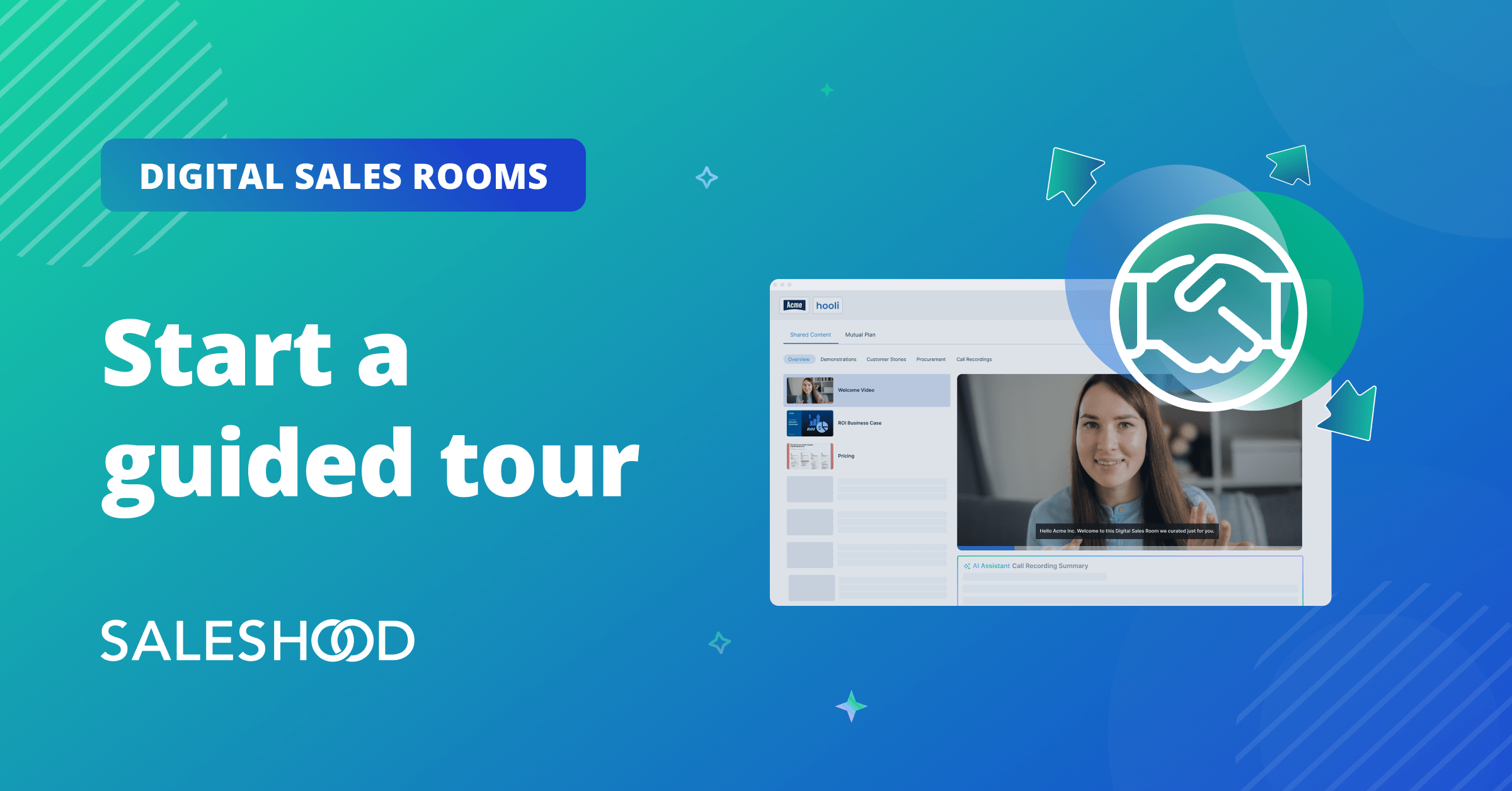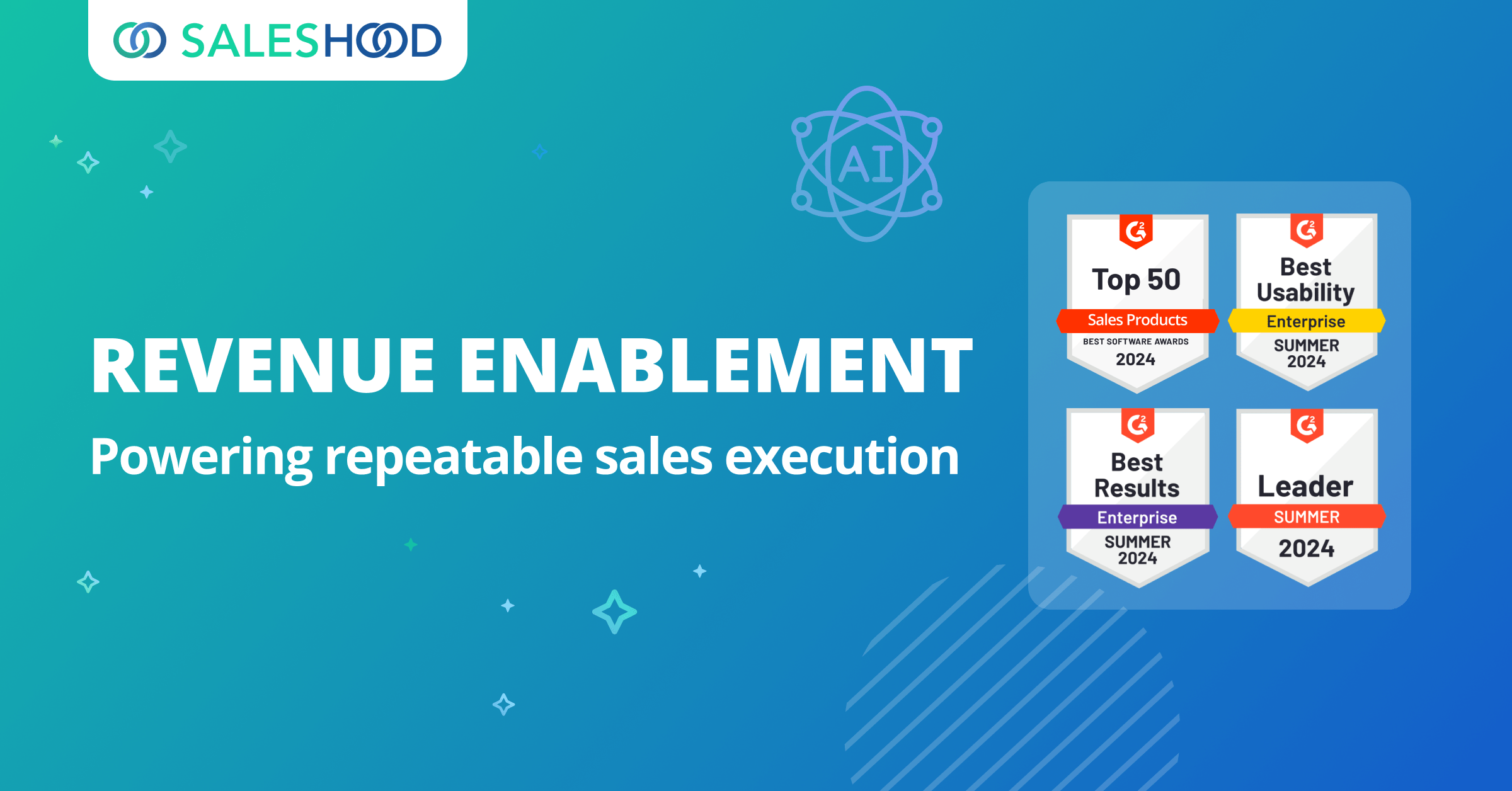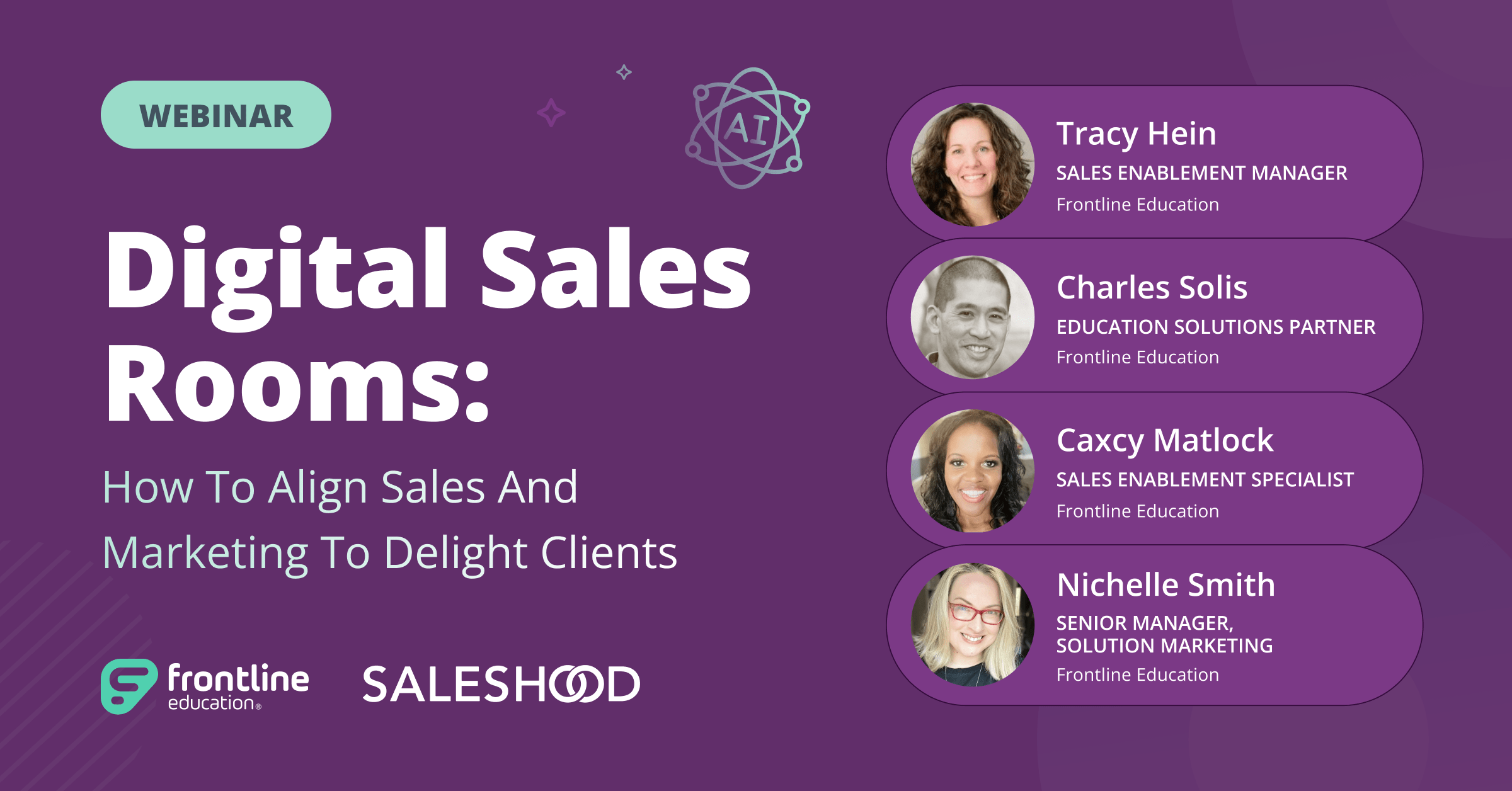The Sales Enablement market is evolving fast.
Until recently, platforms in the space offered a patchwork of features, each attempting to solve the sales enablement challenges in their own way. Coupled with limited access to free trials and public knowledge bases, it’s incredibly difficult for sales, marketing and revenue operations leaders to find the right platform for their teams.
To help you find the right solution, we spent three weeks researching SalesHood and Seismic.
We analyzed all YouTube videos, user reviews, marketing materials, and demos we could find online. We even spoke with industry experts and former clients to get a comprehensive understanding of the platforms and the entire market.
Here are our conclusions:
Seismic is recognized for its robust content management, analytics, and approval management features, making it ideal for large companies with complex content needs — especially in highly regulated industries like finance or pharmaceuticals. Its “Planner” and “LiveDocs” functionality offer unique control over content planning, management, and dynamic sharing. However, its complexity, siloed architecture, and steep learning curve aren’t ideal for fast and lean organizations or those seeking rapid deployments and quick sales cycles.
Seismic’s strengths in content management stem from its origins as a content management solution for large marketing teams. Even though they now position themselves as a Sales Enablement Platform, their content management legacy often leads to challenges in realizing revenue outcomes, improving sales productivity, lengthy setup times, and poor content activation and mastery.
On the other hand, SalesHood was built as a complete Revenue Enablement Platform from the start.
It has the most intuitive and practical content organization system, coupled with advanced AI-powered features like content audit (to keep your enablement content fresh) and real-time pitch practice (to help teach your sales team how to activate content).
Unlike Seismic’s siloed learning system, SalesHood offers a powerful and easy-to-use learning management experience. Its customizable “Huddles” and “Paths” allow you to build complete internal courses to onboard sales reps and help them perform at their peak all year round. Meanwhile, its Digital Sales Rooms and Mutual Action Plans fill Seismic’s gap in buyer engagement and repeatable sales execution.
SalesHood’s approach is holistic. It’s made for agile teams where sales & marketing collaborate to swiftly adapt to market changes, seize new opportunities, and achieve their revenue goals faster.
If the above description resonates with you, reach out and see exactly how SalesHood meets your needs.
In this in-depth article, we’ll compare Seismic vs SalesHood across their three core use cases:
- Content Management
- Sales Readiness and Learning
- Digital Sales Rooms and Client Engagement
We’ll also touch on their AI capabilities, engagement analytics, and the overall user experience to provide a well-rounded view of each platform’s strengths and weaknesses.
Note: This article is 6235 words long and highly detailed. If at any point you feel like expert guidance might help you reach a conclusion faster, feel free to contact our team. They’re here to help you navigate the complexities of the Sales Enablement landscape and find the best platform for your organization.
Let’s begin with an overview.
Seismic vs SalesHood: Comparison Summary
Seismic | SalesHood |
|---|---|
 |  |
Content Library Management |
|
| Traditional folder structure in the Library tab. Provides DocCenter for specialized content hubs. Offers content syncing from external sources like SharePoint and Google Drive. | Features a customizable hierarchical folder system with pages for flexible organization. Offers unique AI-powered content audit, automatic archiving, and synchronized content across the platform and your cloud apps. |
Content Organization and Discovery |
|
| Provides TeamSites for content hubs with limited customization. Stands out with a Planner feature for managing content projects and tasks. Offers in-depth approval and versioning system. | Offers fully customizable pages with a drag-and-drop editor. Integrates learning elements, AI-generated summaries, and client site lists. Provides a marketplace for sharing templates. |
Content Analytics and Insights |
|
| Provides powerful content analytics and comprehensive insights on content performance and engagement. Most suitable for organizations prioritizing in-depth analytics. | Offers extensive content insights based on type, location, owner, tag, and timeframe. Provides internal and external engagement metrics, revenue impact, and unique search activity insights. |
End-User Experience |
|
| Modern, content-focused interface with extensive navigation. The Workspace tab is central for sales reps. Its complex structure requires more time for familiarization and onboarding. | Provides an intuitive, fully customizable interface with personalized homepages. Offers quick access to learning tasks and active documents. Allows managers to customize homepages for different segments. |
Training and Onboarding |
|
| Features robust Seismic Learning with AI-assisted lesson creation. Offers diverse lesson elements and chained learning paths. Includes coaching plans for personalized rep development. | Provides a flexible learning structure with customizable Huddles and Paths. Offers 32+ pre-built sales training lessons, customizable grading criteria, and unique features like optional modules and prerequisites. |
Team Performance Insights |
|
| Focuses on skill-based performance analysis. Allows coaches to assess and grade skills. Provides an overview of sales reps' skills compared to team members. | Offers Path- and Huddle-specific progress tracking. Provides completion metrics and assessment results. Allows awarding of certificates or badges upon milestone completion. |
AI Coaching |
|
| Features AI pitch practice with custom prompts and keyword analysis. Generates transcript and scores feedback metrics. Analyzes correct and incorrect keyword usage. | Provides advanced AI-powered pitch practice with real-time analysis. Offers extensive feedback on presentation aspects, including tone, pace, and conversational style. Generates detailed improvement suggestions. Able to easily embed AI Coaching into Pages. |
Digital Sales Rooms |
|
| Provides digital sales rooms, email sharing, and link sharing. Features LiveDoc functionality for dynamic content hubs. Allows comments within sales rooms for client interaction. | Offers quick share, Client Sites, and integrated messaging. Provides easy-to-create branded deal rooms with external content. Includes Mutual Action Plans for buyer-seller alignment. |
Buyer Engagement Insights |
|
| Offers detailed session analytics in the Engagements toolbox. Displays total session time, time spent on each content piece, and user details like location and machine information. | Provides comprehensive Client Site analytics, including overall metrics and site-specific insights. Offers CRM integration for impact tracking and automatic logging of content activity interactions. |
G2 Reviews |
|
| 4.7 rating from 1,551 reviews | 4.6 rating from 694 reviews |
Best For |
|
| Large enterprises with different departments in need of complex content management, prioritizing in-depth content analytics and skill-based team performance tracking. | Agile sales and marketing teams that need flexible content management, powerful training tools, and AI coaching in a unified and intuitive revenue enablement platform. |
Get a Free Demo |
|
What is Seismic?
“Sales enablement via data-driven content management”

In 2010, five colleagues founded Seismic to address a recurring problem in client-facing teams: inefficient content management and personalization. Inspired by financial advisors’ makeshift pitchbooks, CEO Doug Winter and his team set out to revolutionize sales enablement software, leveraging the emerging cloud technology to create a more efficient solution.
Seismic‘s flagship product, the Seismic Enablement Cloud™, has evolved into a comprehensive platform for sales and marketing teams. It offers powerful content management with robust analytics, an in-depth approval and versioning system, and the unique “LiveDoc” functionality for dynamic content sharing. The platform also includes “Seismic Learning” for team training, “LiveSocial” for social media engagement, and AI-powered features for content creation and pitch practice — all designed to streamline the sales process and enhance interactions with potential customers.
Seismic’s feature suite is particularly well-suited for large enterprises with long and complex sales cycles, extensive content libraries, and large specialized teams, requiring advanced analytics and strict content governance.
What is SalesHood?
“The all-in-one revenue enablement platform”
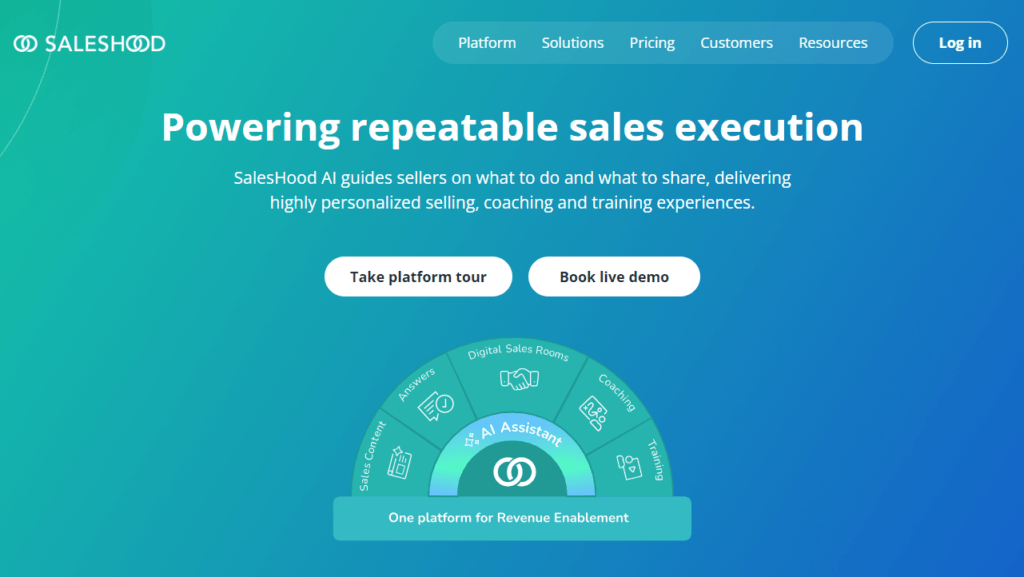
While leading Salesforce’s global Sales Enablement function, Elay Cohen helped grow the business from $300 million to $3 billion. Frustrated with the inefficiencies of traditional sales enablement, he founded SalesHood in 2013 to streamline and automate the process using video, mobile, data, and AI technologies.
SalesHood’s Revenue Enablement Platform (REP) stands out with its comprehensive approach to sales readiness, content management, and buyer engagement. It offers customizable learning paths with AI-powered pitch practice, intuitive content organization with automatic auditing, and versatile Client Sites for digital sales rooms. The platform’s unified structure allows for seamless content updates across training, sales pages, and libraries, while its integrated messaging feature facilitates real-time communication with prospects and clients.
SalesHood is ideal for sales and marketing teams seeking to enhance their sales processes, maintain consistent messaging, and drive measurable outcomes. Its rapid setup and flexible customization make it particularly suitable for organizations looking to quickly implement a powerful sales enablement solution that scales with their growth.
Want to see what SalesHood looks like? Take a guided tour or reach out and see exactly how SalesHood meets your needs.
Seismic vs SalesHood: Content Management
Seismic’s approach is traditional and excels in insights but requires dedicated teams, while SalesHood’s content organization is the most intuitive and customizable.
In this section, we’ll cover everything you need to know about the three platform’s content management features. Everything you can do with them to help your team perform at their peak.
For easier navigation, we split this section into three subsections:
- Content Library Management
- Pages For Content Organization and Discovery
- Content Analytics and Insights
Content Library Management: Seismic is intuitive but inflexible with traditional folders. SalesHood also has intuitive folders and is more flexible.
Seismic | SalesHood |
|---|---|
Seismic houses all your content in the Library tab — a straightforward folder system.
When you open the library dashboard, you’re presented with quick insights about your content, such as how many pieces are expiring soon, recently expired, and their overall engagement metrics. This is where you create folders and upload content. You can also sync content from external sources like SharePoint, Google Drive, and OneDrive.
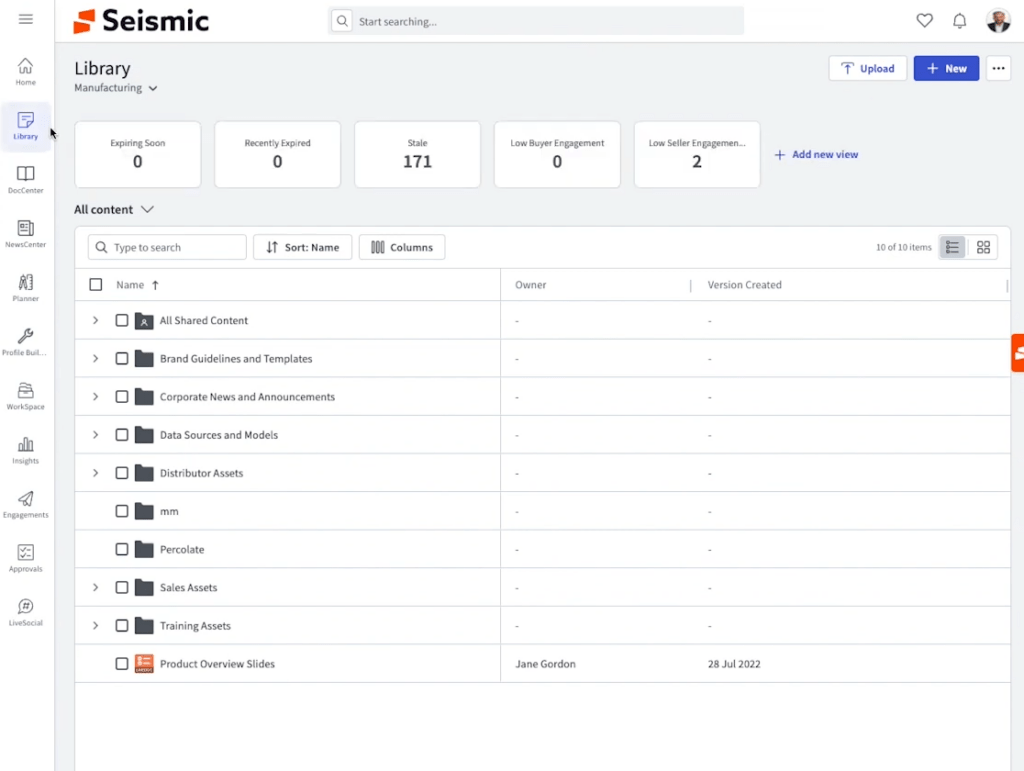
If you want to organize content into quickly discoverable content hubs, Seismic offers the DocCenter toolbox.
Here, you can create specialized pages for different needs, helping you organize and surface content around specific topics. These pages serve more as boards to pin content to and aren’t very customizable.
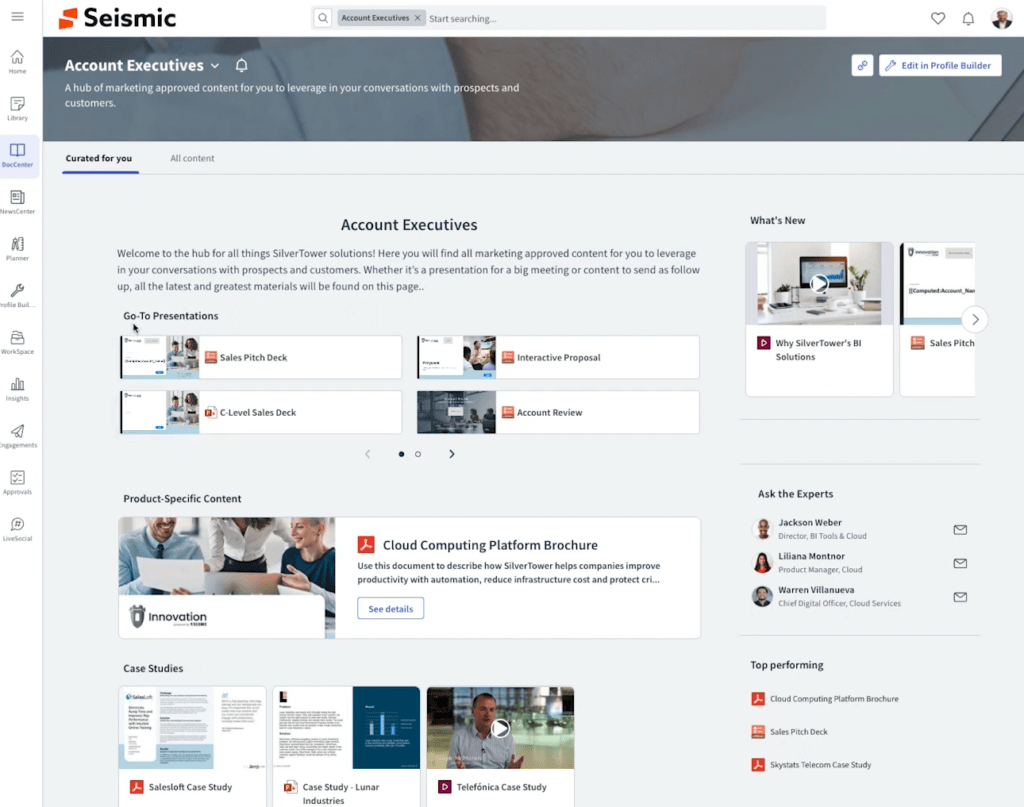
Seismic’s approach is more traditional and familiar if you’re accustomed to standard file management systems. One drawback we noticed with Seismic is that it doesn’t clearly show what content is published or isn’t, so we constantly had to double-check on the user’s end
It’s also worth noting that Seismic offers global search functionality, located at the top center of the screen.
Then there’s SalesHood.
With SalesHood, you manage content in the “Content” tab, which includes both — your “Pages” and your Library.
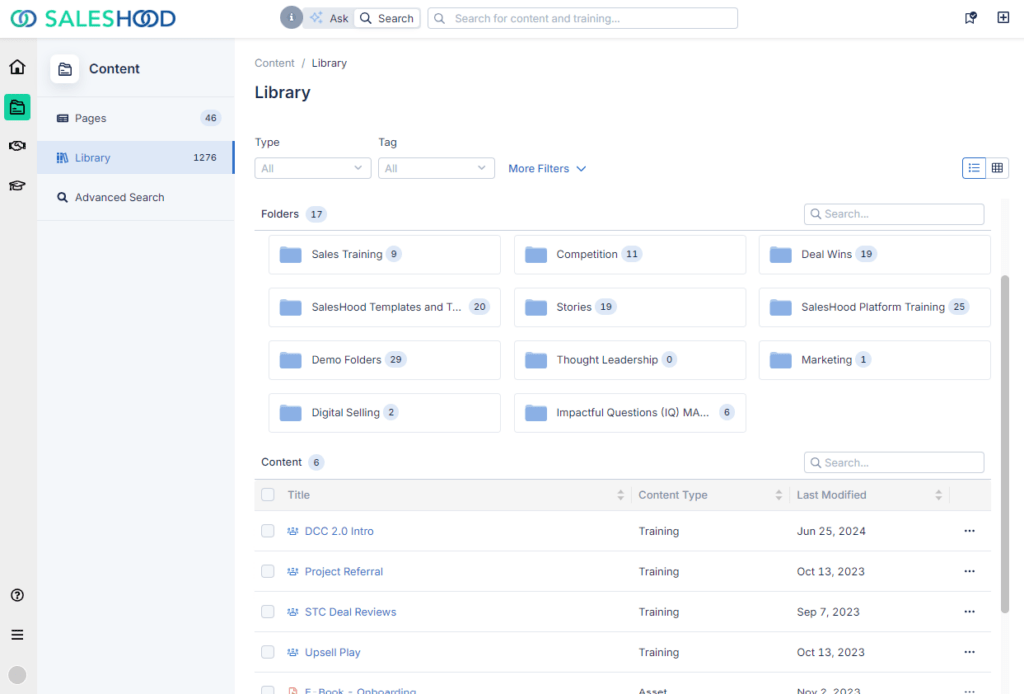
The library stores all your content in a customizable, hierarchical folder system. You can add folders, files, “Huddles” (more on this in the learning section), or links, and customize your folder structure with pins, tags, permissions, bookmarks, and RSS connections.
You can also sync your library with Dropbox, Box, and Google Drive.
Then there’s the “Pages” tab, where you create and manage pages, page drafts, and templates. Pages can serve the same purpose as Seismic’s DocCenter hubs but are more flexible and way more customizable (more on this in the next sub-section).
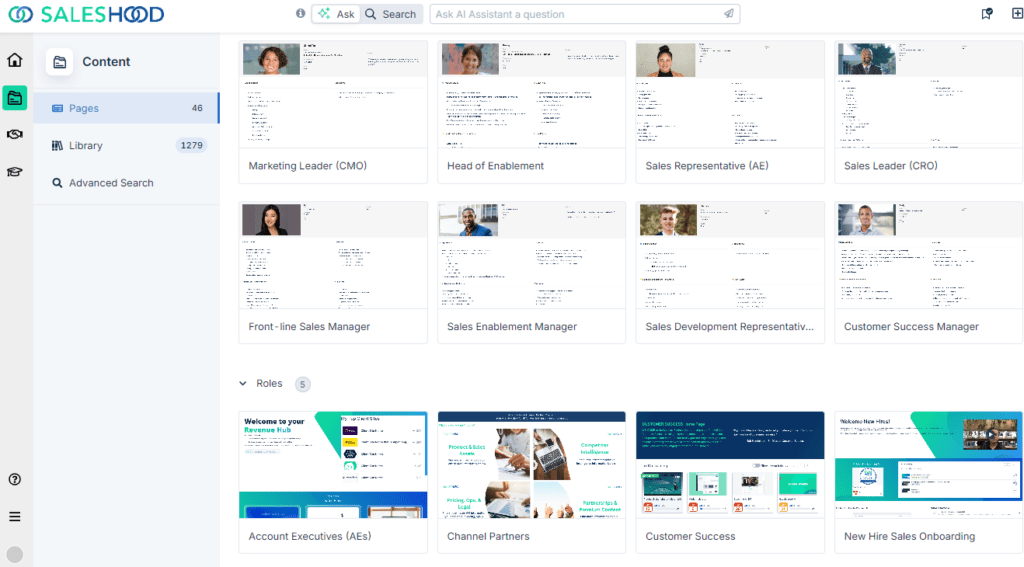
SalesHood’s unique content management features compared to Seismic are:
- Advanced, AI-powered content audit: Identifies content that hasn’t been viewed in the last quarter, is orphaned or expired, or has unoptimized metadata.
- Automatic content archiving: Unlike Seismic, SalesHood allows you to automatically archive content once it expires.
- Synced content updates: Changes made to content are reflected across the entire platform. For example, if you modify a huddle in a course, the changes get synced in your library and on every page that huddle is accessible from.
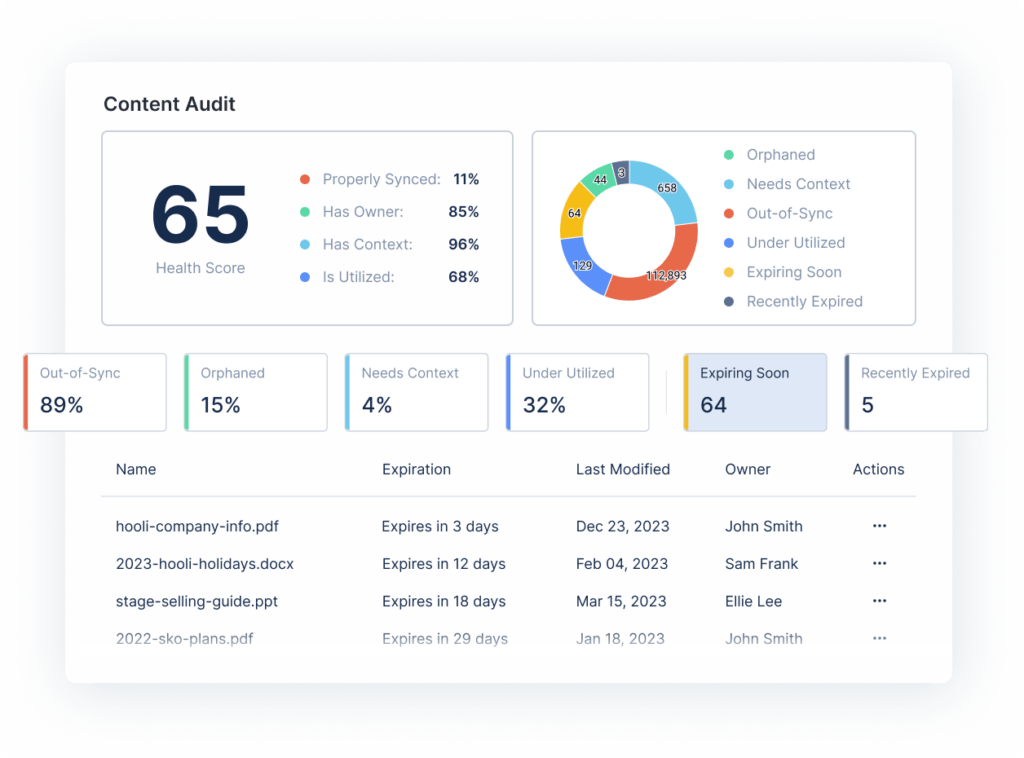
SalesHood also includes a global search at the top of your interface that you can use to find all your content, across your learning, sales pages, and library. It’s distinct from Seismic because it includes an AI Assistant that surfaces information from documents in seconds (including the sources).
When it comes to implementation, SalesHood outpaces Seismic. It allows you to have a sales instance up and running within 30 seconds. This rapid setup includes AI, content, pitches, sales training lessons, enablement templates, and other essential elements.
Pages For Content Organization and Discovery: Seismic provides in-depth planning tools, and SalesHood excels in ease of use, content management, and best-in-class readiness in one experience.
Seismic | SalesHood |
|---|---|
In Seismic, you use the “Profile Builder” tab to create content hubs for different internal profiles or categories. They call these profile or category hubs “TeamSites”. Once created, the TeamSites live in the “DocCenter” tab where anyone with access can quickly find them.
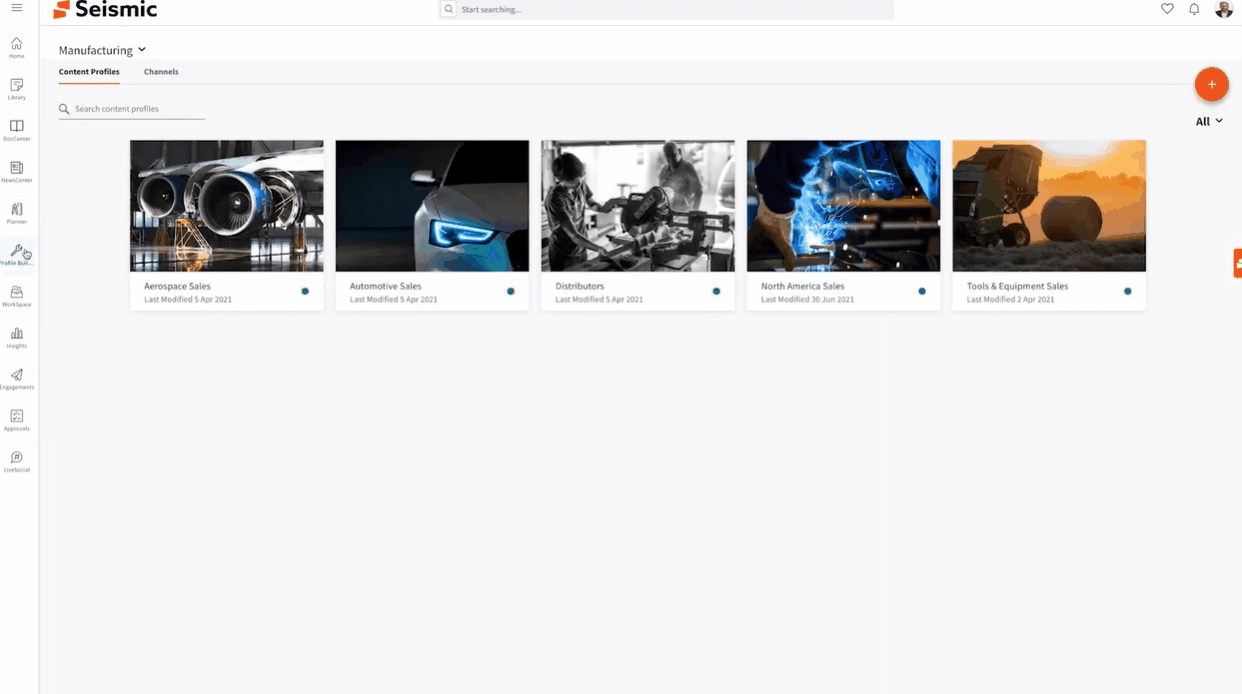
While we couldn’t directly access the team site editor, based on how they look on the front end, we can guess that Seismic offers limited customization and branding options. For example, branding seems limited to a single banner image, while hub layouts seem fixed, so you’re likely restricted to customizing sections only within preset layouts.
Having said that, Seismic stands out with its “Planner” feature, which is unique among the three platforms. It’s a toolset for managing content projects and tasks in a centralized location. With it, your marketing team can:
- plan and manage content marketing projects and tasks (1),
- receive and manage team requests (2),
- and create project templates (3).
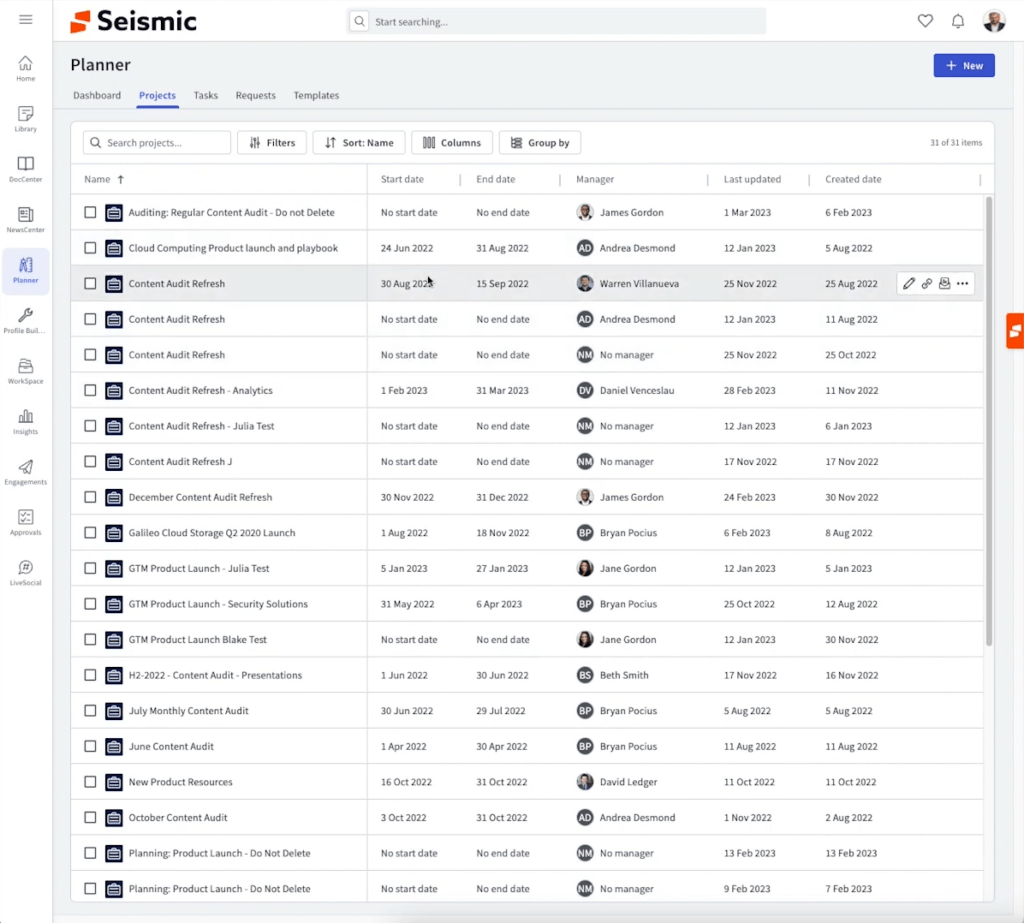
Seismic also offers an in-depth approval and versioning system; especially useful for teams requiring strict content governance.
SalesHood‘s approach to Pages goes beyond content organization.
Its Pages work as hubs for learning, coaching, content navigation, and peer-to-peer knowledge sharing. The Page creation process is straightforward and flexible, following its philosophy: “Move quick, do what you want and nothing you don’t want.”
SalesHood’s Pages feature offers:
- A drag-and-drop editor for creating fully customizable pages.
- Options to include text, buttons, images, videos, spacers, and dividers.
- Integration of learning elements with Training, To-Do, and pitch practice components.
- Personalized AI Coach to keep sellers fresh and ready.
- Embedding of content with “Asset”, dynamic asset list, and trending assets features.
- An AI Publisher that writes summaries based on your
- Client Site lists for pages linking to sales resources.
You can decide who can see the page; they can be homepages or topic-specific pages (e.g. some people use them for sales plays while others use them for product plays). And, unlike Seismic’s Content Hubs, you can completely customize and brand your SalesHood pages.
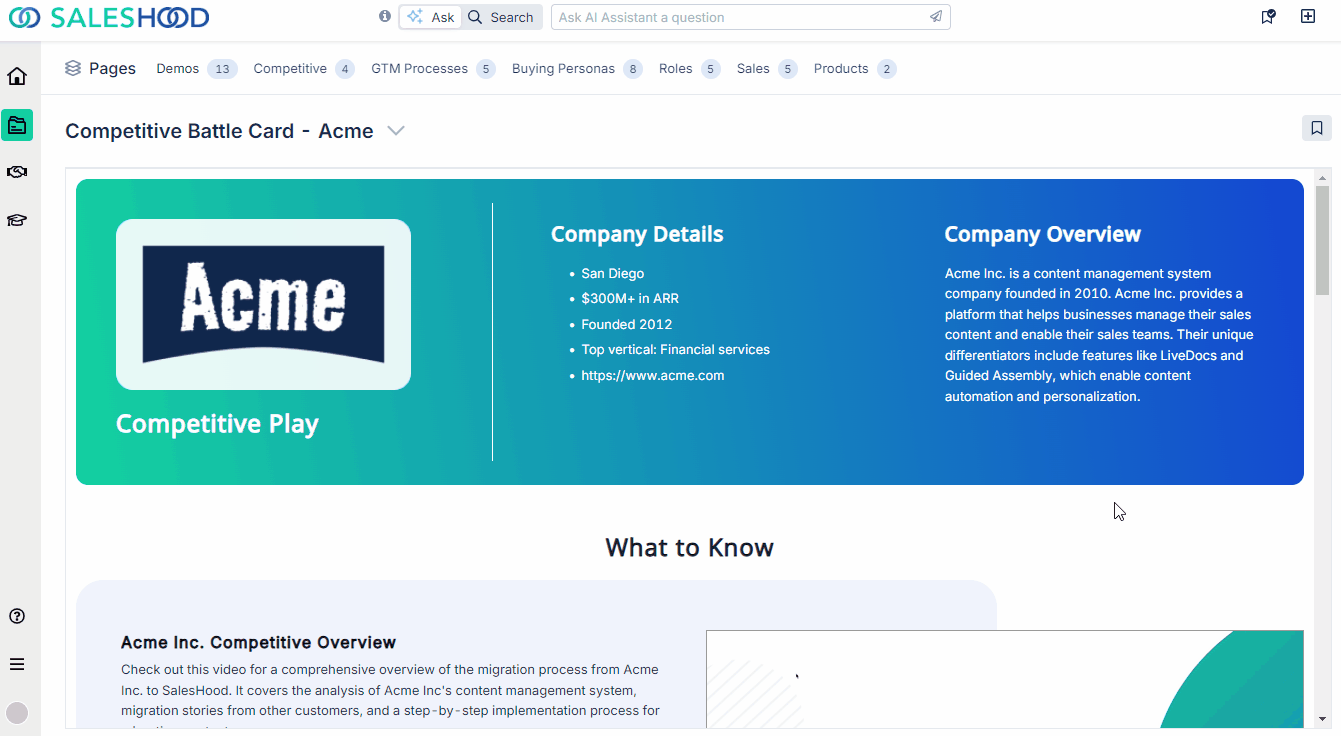
For example, you could create Pages for specific use cases and needs that look completely different.
A Page, specialized for sales onboarding can have embedded courses and training huddles with a green color code to distinguish it from a purple page, made for quick content access on live calls with case studies and SOP materials.
SalesHood also allows you to create and use templates for faster page creation and provides a marketplace where users can share and access free templates for content and Pages.
Content Analytics and Insights: Both offer content analytics; SalesHood’s are advanced, while Seismic’s are more powerful but require data teams to make full use of.
Seismic | SalesHood |
|---|---|
We couldn’t get direct access to Seismic’s content analytics for this comparison.
They’re available in the “Insights” tab and, as far as we understand, are the most powerful out of the three platforms. So, if content insights and analytics are your biggest pain point, Seismic is probably your best option. However, you need dedicated data analysts to get the most out of its toolset.
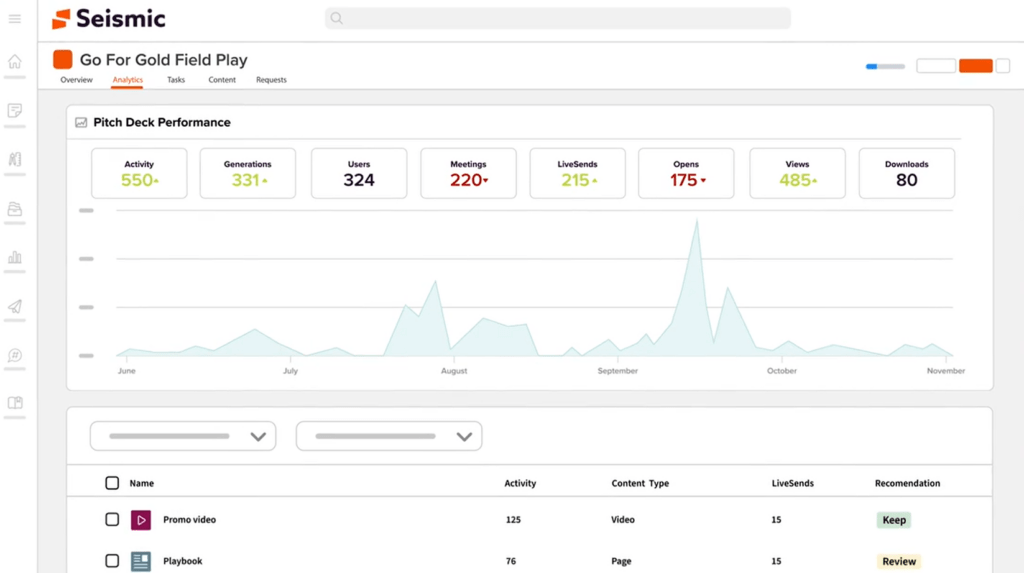
In SalesHood, you access “Content Insights” under the Content tab. This feature allows you to analyze your content based on its Type (format), Location (folders), Owner, Tag, and Timeframe.
The insights provide a complete overview of your content, including:
- Asset count
- Asset owners and tags
- Internal engagement metrics (views and view time)
- External engagement metrics (client site views and view time)
- Revenue impact (if your Salesforce CRM is connected)
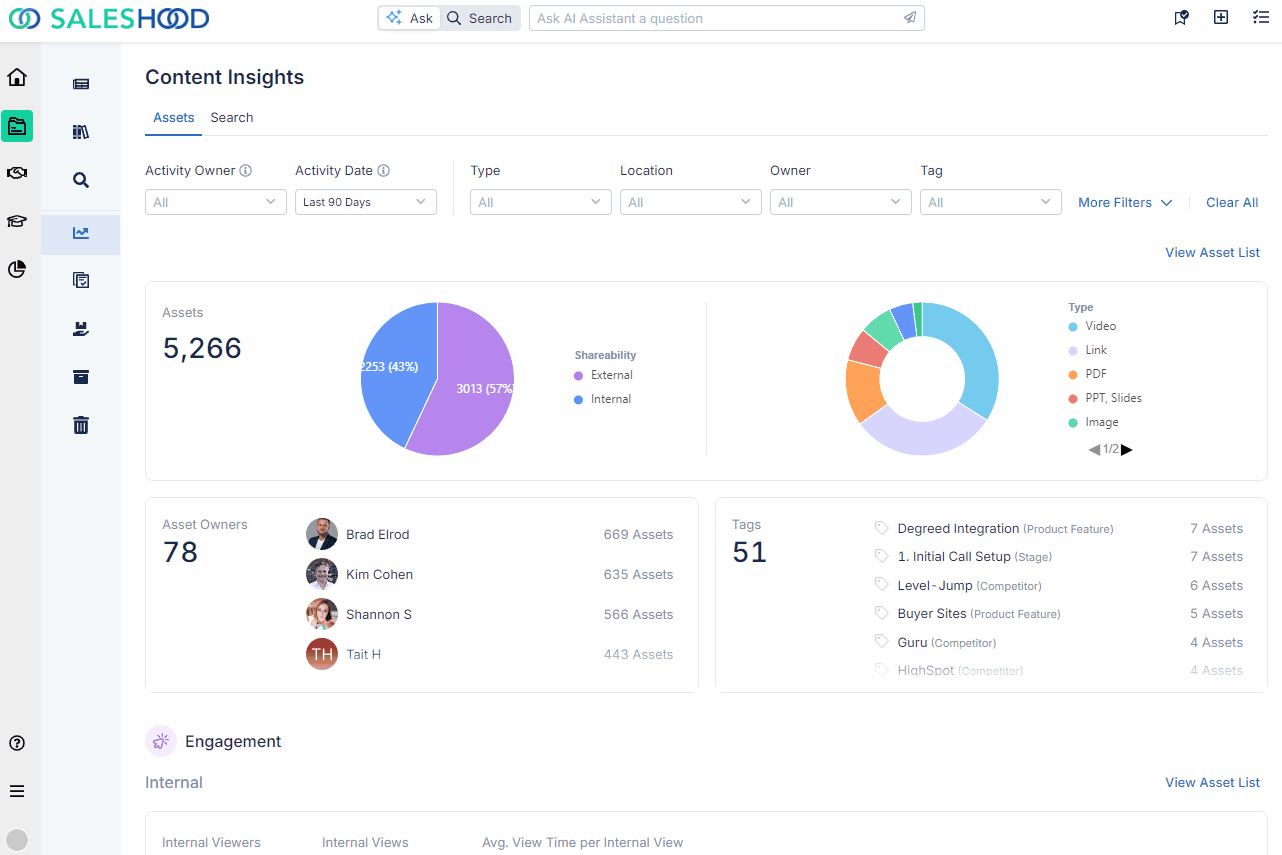
SalesHood also offers Search activity insights. This is similar to Google Search Console, but for your organization’s internal search. It gives your marketing team another angle to identify what people are looking for internally.
Seismic vs SalesHood: Sales Readiness and Learning
Seismic’s training features are robust but complex. SalesHood offers the most powerful and flexible learning experience with customizable huddles, paths, and gamification.
In this section, we’ll discuss everything that has to do with your team’s learning and preparation. How the platforms help give them the skills, knowledge, and coaching they need to perform at their best. For easier navigation, we split this section into four sub-sections:
- Platform Overview and End-User Experience
- Onboarding and Training Features
- Performance Tracking and Analytics
- AI Integration and Advanced Features
Platform Overview and End-User Experience: Seismic is modern and content-focused but complex, while SalesHood is intuitive and completely customizable.
Seismic | SalesHood |
|---|---|
Seismic greets you with a homepage upon sign-in. It includes sections for quick access to featured content, news updates, new content, top interacted content, and links to playbooks.

The left navigation bar in Seismic includes tabs for Library, DocCenter, NewsCenter, Planner, Profile Builder, WorkSpace, Insights, Engagements, Approvals, and LiveSocial. This is also where you will find Seismic Learning if you have it.
As a sales rep, you’ll most likely spend the most time in the “Workspace” tab when working and in the “Learning” tab when refining your skills.
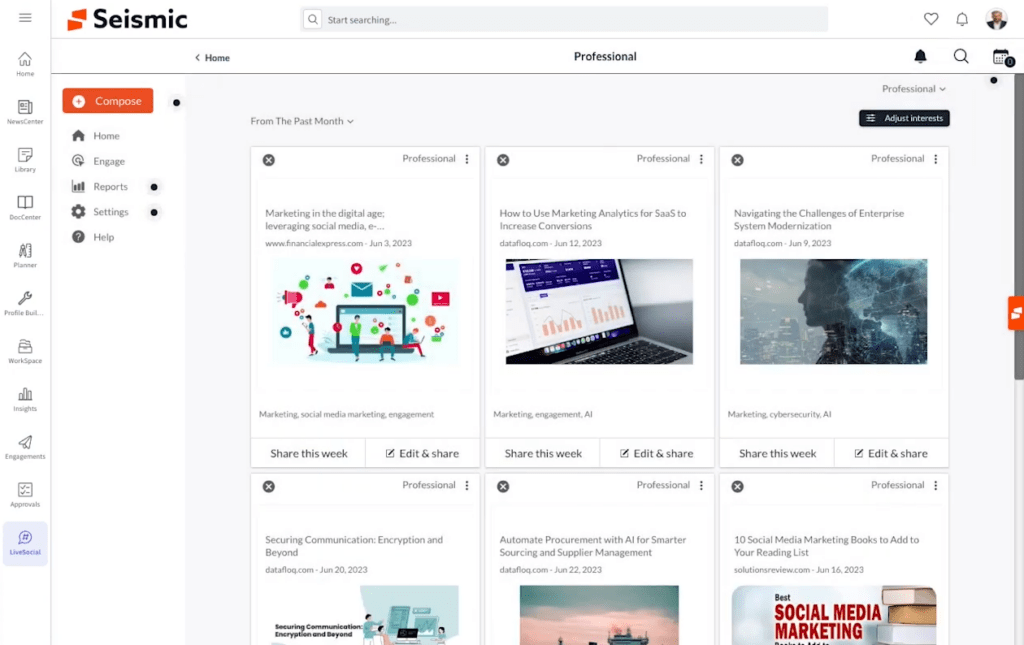
Then there’s SalesHood. Like Seismic, it also greets reps with a personalized homepage tailored by tenure and role. However, unlike Seismic, this homepage is where you’ll likely spend the most time if you’re a sales rep.
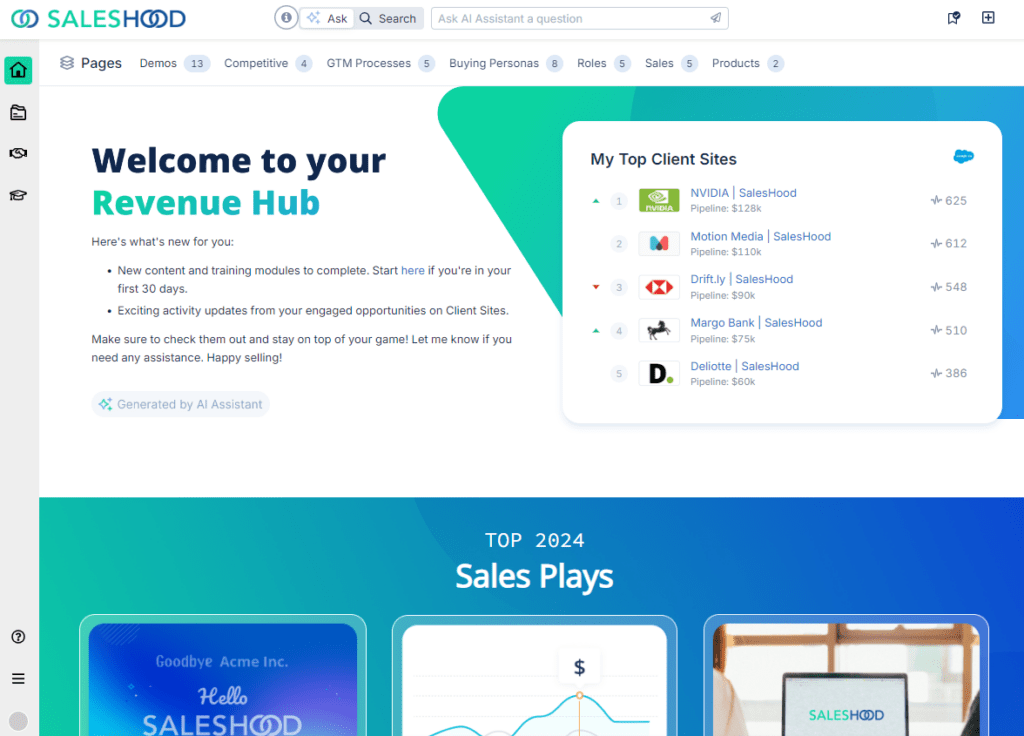
You can find all your pages in the top navigation bar; accessible with a single click. The homepage itself highlights your learning to-do on the left, while on the right, you get access to your most active documents and a summary of any new or recently modified assets you haven’t opened yet.
If you’re a manager, you can replace specific groups’ or segments’ homepages with a page, allowing you to serve different content to different segments.
When refining your skills, you’ll spend most of your time in “huddles”, which you’ll find and navigate either via specialized pages or in learning paths.
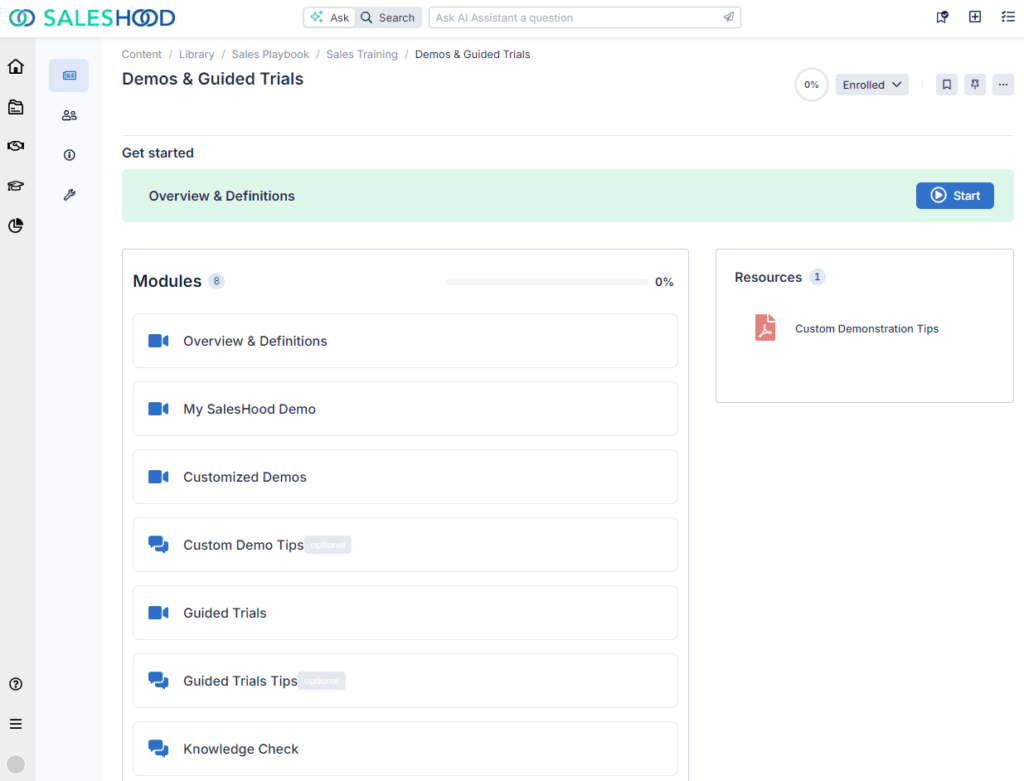
Onboarding and Training Features: Seismic’s learning is robust and customizable, while SalesHood leads with flexibility and features.
Seismic | SalesHood |
|---|---|
Seismic acquired Lessonly a few years ago and renamed it to “Seismic Learning”. Since then, they’ve gradually integrated it into the platform and expanded its features.
When you open the learning toolbox as an enablement manager, you see a different view than a sales rep. The “Content” tab allows you to manage learning material and create new lessons, paths, practice scenarios, certifications, or learning journeys.
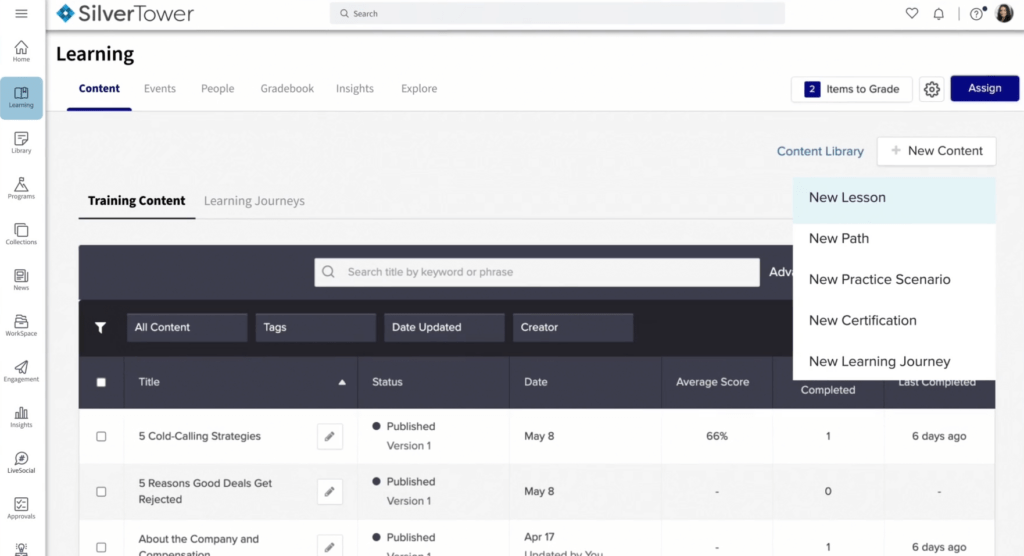
When creating new lessons, you can use templates and Seismic’s AI helper to generate an initial lesson based on your Seismic library material so you don’t have to start from scratch.
You’ll then get redirected to the lesson builder.
This is where you can add more elements to flesh out the lesson. These elements include text, flipcards, images, embeds, video, audio, library content, and more. Lessons are also where you can test your reps knowledge with knowledge checks, questions, and practice elements.
Once you have lessons built, you can chain them together into paths and learning journeys to create complete courses.
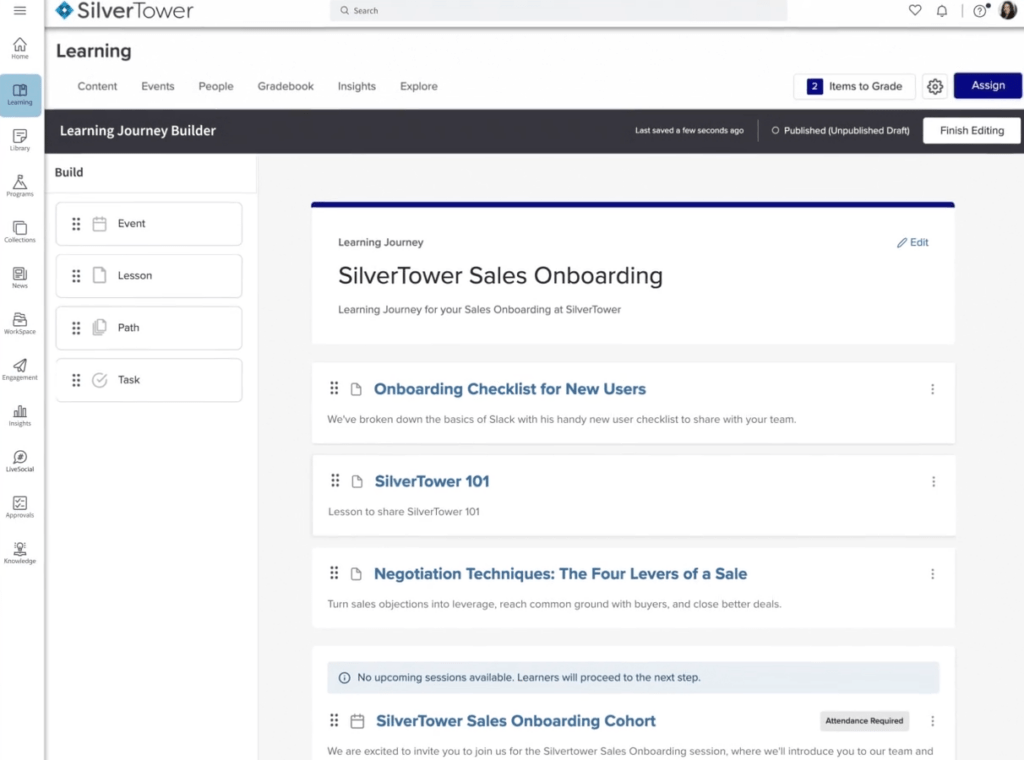
The other part of Seismic’s learning is coaching, which happens on “Coaching Plans”.
These are essentially pages, personalized for specific sales reps, where they can find “Action items” that help them upskill in preparation for their next assessment. In comparison, SalesHood allows you to do the same thing with its flexible Pages.
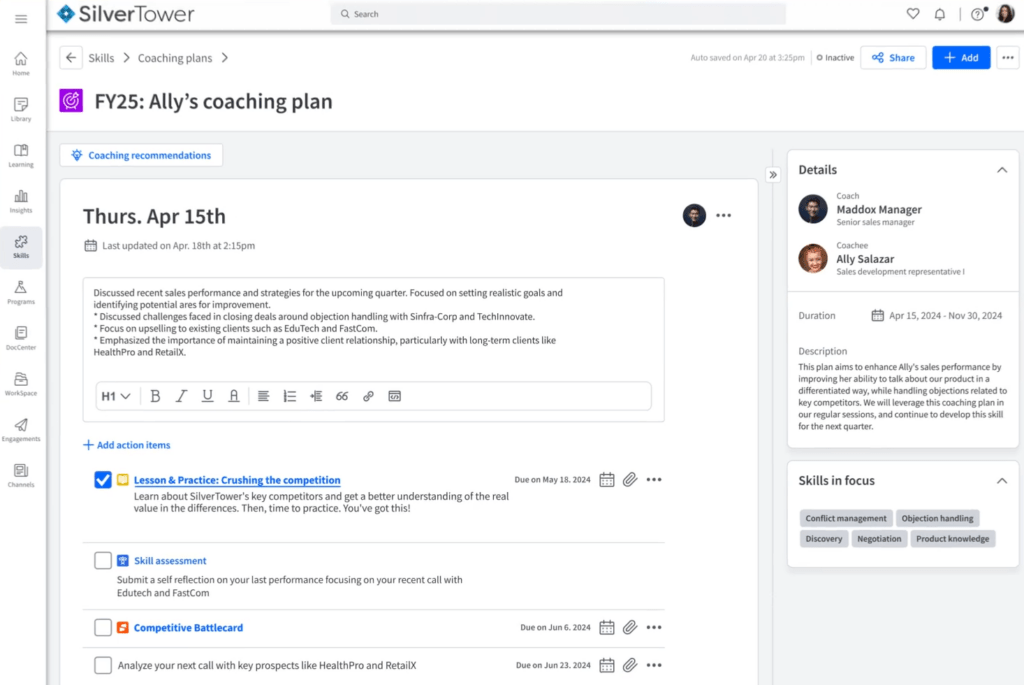
Speaking of SalesHood — here, you create and manage training content in the “learning” module.
This module is divided into two main sections: “My Learning” (shows your current, completed, and overdue training content) and “Manage Training, where you can build and manage training courses if you have permission to do so.

SalesHood allows you to structure learning on two levels:
- Huddles: basic learning modules containing key building blocks like exercises, tests, pitch practice, videos, assets, SCORM content, and live event scheduling. SalesHood knows the importance of peer-to-peer, social learning, and collaboration — it’s where the name comes from.
- Paths: allow you to organize and sequence Huddles, single assets, or external events to create full courses. Sales teams love how organized Paths are and enablement practitioners love how easy it is to set up and scale them.
When you create a new Huddle, you can set it to “open to everyone” or “scheduled” (available to assigned participants for a certain time only). Besides adding the learning elements, you can customize the Huddle by pinning library content and adding a featured image, description, instructions, or outcomes.
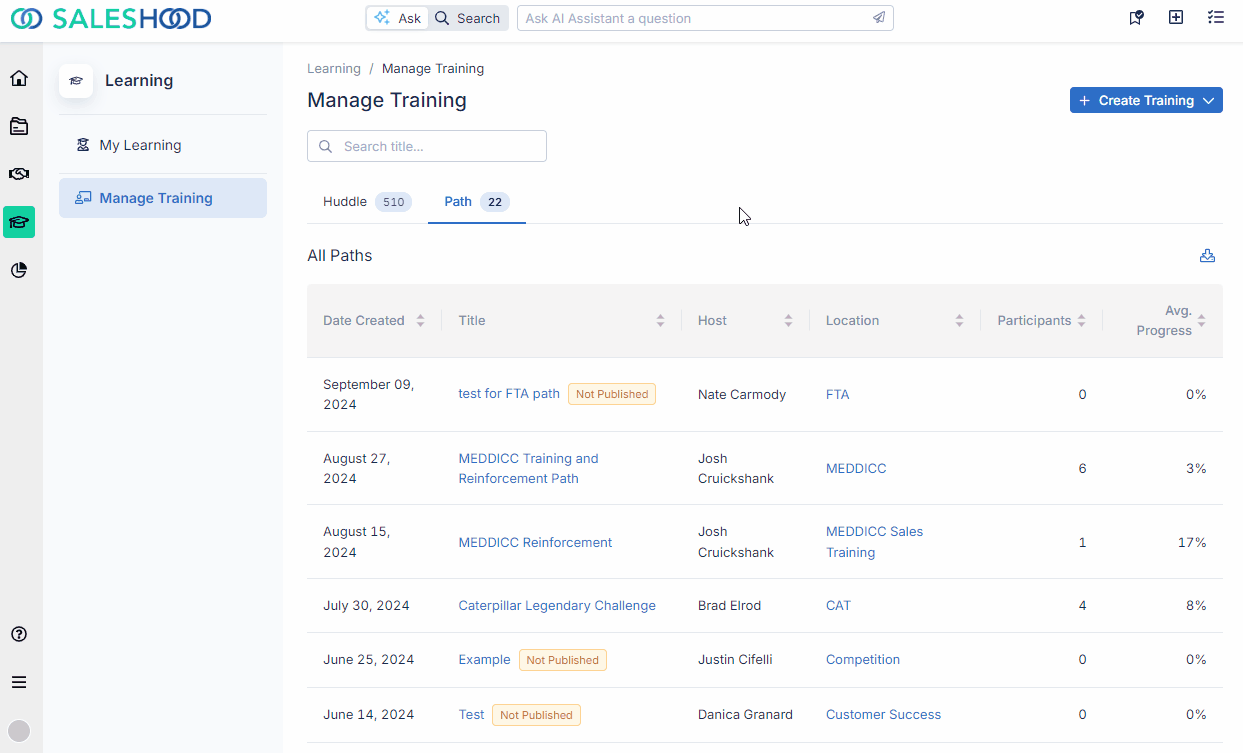
When you have a few Huddles, you can chain them in Paths; equivalent to courses.
Paths can be self-paced, scheduled with a due date, or dynamic where the host sets a duration that determines each participant’s due date upon joining. They allow you to organize relevant content into sections (like chapters) and blocks (sub-chapters containing assets like huddles or documents).
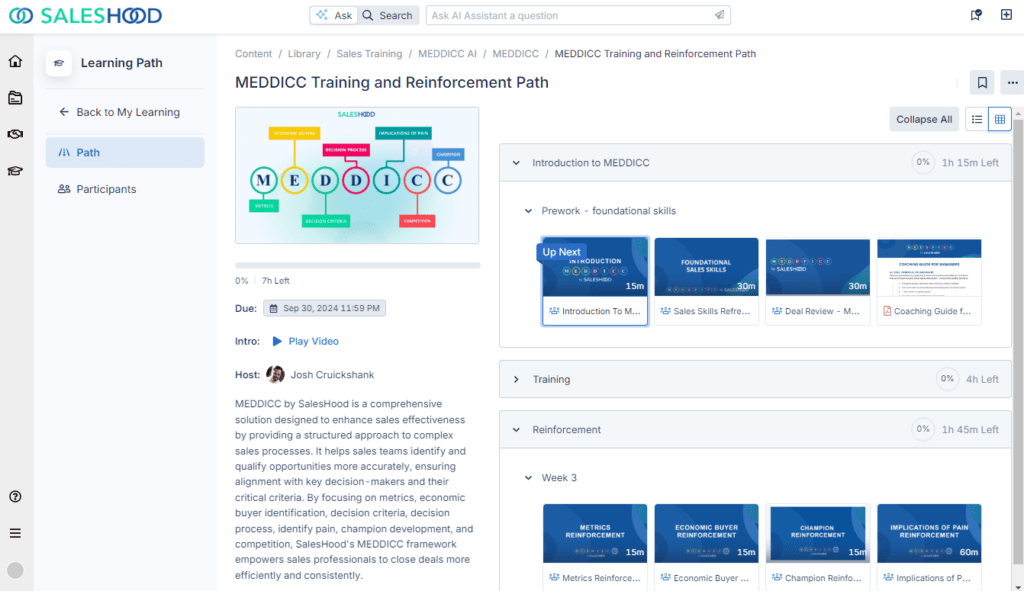
SalesHood allows you to mark Huddles as optional, set prerequisites, or automatically complete them for users who’ve finished them in another journey. This feature is unique to SalesHood and is possible due to its unified library that tracks user interactions across the platform.
SalesHood also offers 32+ pre-built sales training lessons that you can use out of the box or modify to help you quickly set up new courses.
Considering that it allows you to embed training content onto pages and customize them however you want, you could even create completely custom learning experiences with SalesHood — built of multiple Paths, Huddles, resources, pitch practice, and other interactable elements.
The last thing to look at are the coaching features.
In SalesHood, you can set up Test modules to require previous module completions and define the maximum number of attempts. Meanwhile, for Pitch modules, you set review criteria for graders. Speaking of, for both of these modules, you can set minimum passing scores and assign graders. It also offers AI assessment and scoring modules to help coaches give better feedback.
Once a rep completes a test or submits a pitch recording, SalesHood notifies graders in the “Coaching Activity” toolbox in the top-right corner, prompting them to assess the submission.
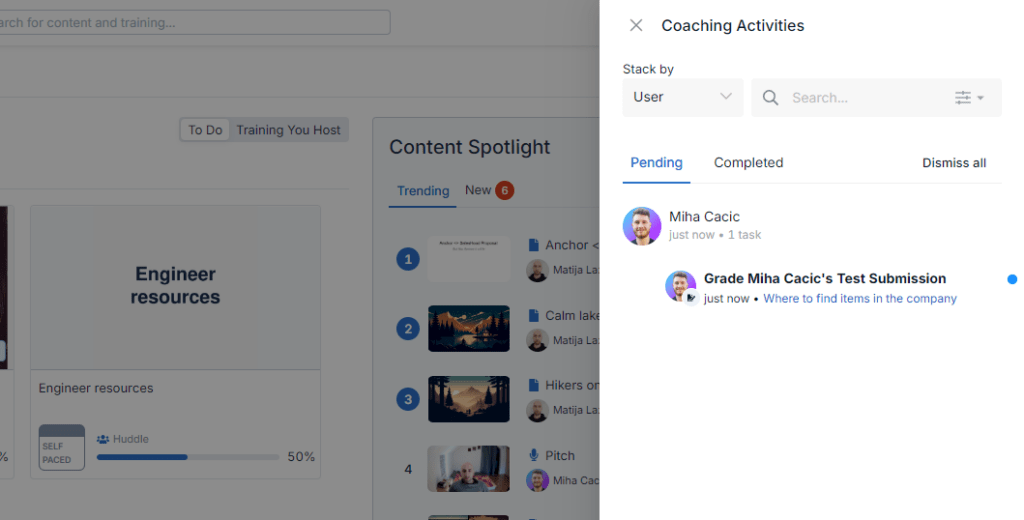
Team Performance Insights and Analytics: Seismic offers learning analytics while SalesHood leverages competitive elements.
Seismic | SalesHood |
|---|---|
In Seismic, sales performance analysis revolves around “skills”.
When reps go through training and assessments, coaches can assess their skills and grade them. This data gets stored in the “Skills” toolbox, where you can get an overview of sales reps’ skills side-by-side with others in their team. This tab is also where you can create assessments, define skills, and create coaching plans.
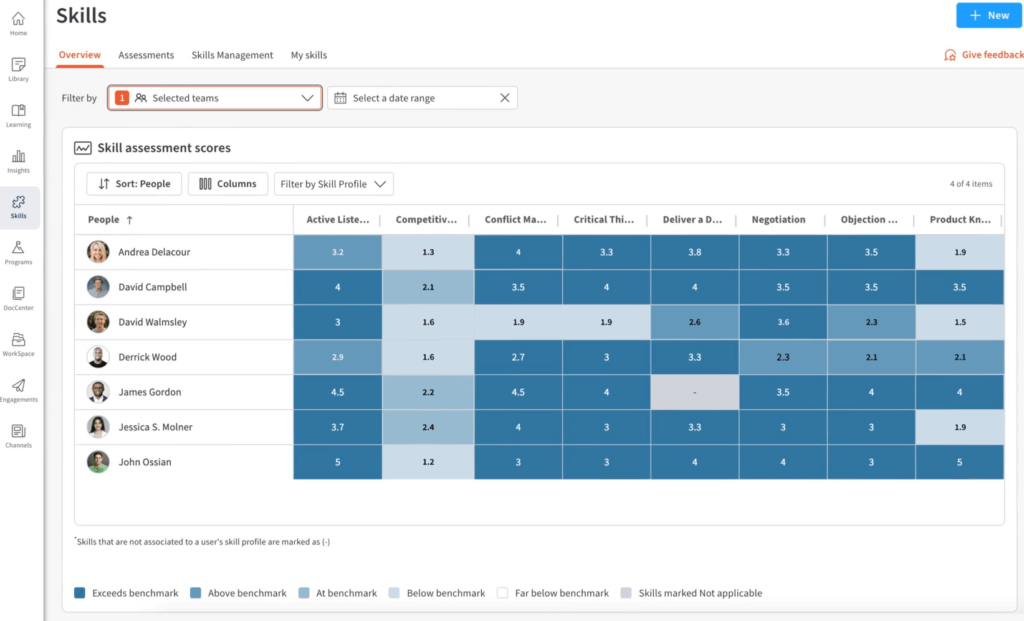
SalesHood doesn’t have a unified dashboard that displays your whole organization’s skill metrics like Seismic. Instead, its progress tracking is path- or huddle-specific.
Paths show basic completion metrics to track each enrolled member, team, or segment’s progress across huddles and other resources. Meanwhile, the exercise-specific completion metrics and assessment results are available in the huddle view.
![]()
Like in Seismic, you can award members certificates or badges once they complete milestones.
AI Integration and Advanced Features: Seismic’s feedback AI allows pitch practice with custom prompts and keyword analysis, while SalesHood takes it even further with real-time insights and more comprehensive feedback.
Seismic | SalesHood |
|---|---|
Seismic also includes AI pitch practice as part of Seismic Learning. You set it up by giving it a prompt and an example for context, then specifying the correct and incorrect keywords to use, and defining what you want it to analyze (filler words, pace, and confidence).
Once a rep uploads a video, the AI coach will highlight the correct and incorrect keywords they used and score the feedback metrics you selected. It also generates a transcript for the rep to analyze.
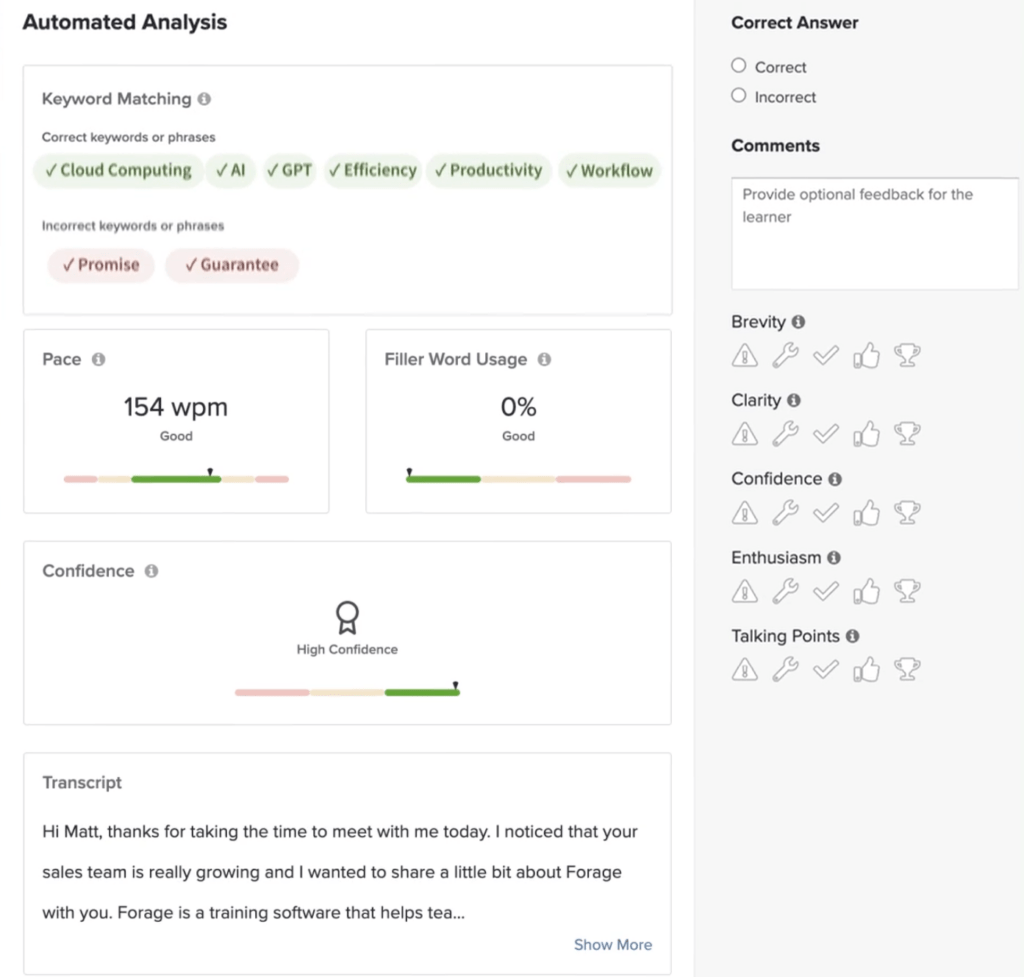
SalesHood takes AI-powered pitch practice to the next level.
As you record your pitch, the AI examines your words in real-time. It identifies phrases you should use and highlights restricted language. Once you’ve finished, it analyzes your recording and provides feedback on multiple aspects of your presentation: tone, pace, inflection, phrase usage, engagement, duration, closing, and conversational style.
Instead of just giving you a transcript of the pitch like Seismic, SalesHood’s AI Coach creates a whole write-up on what the sales rep did well and how they can do better next time.
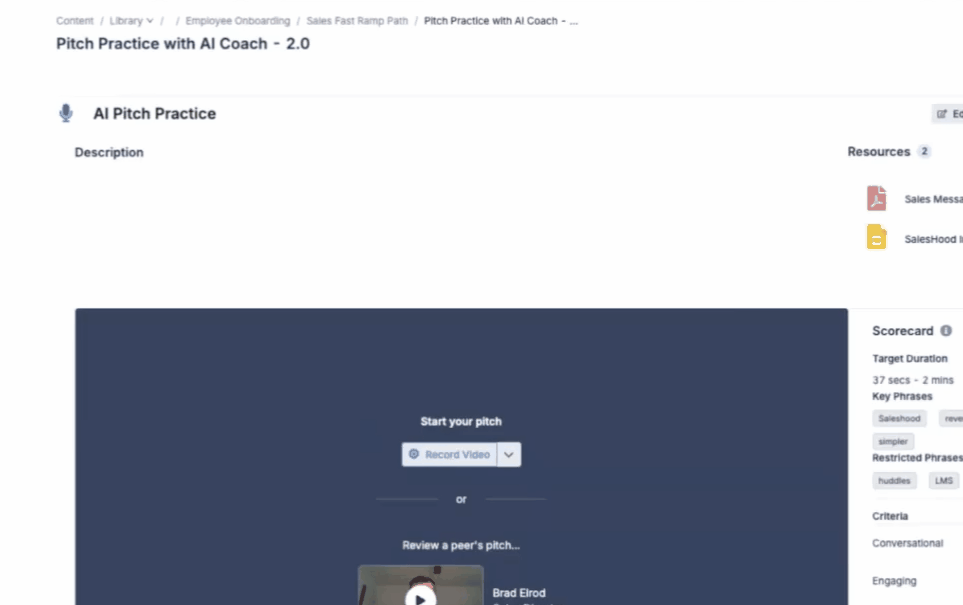
Seismic vs SalesHood: Digital Sales Rooms and Client Engagement
Seismic offers customizable LiveDocs and social media tools, while SalesHood provides versatile Client Sites, the best analytics, integrated messaging, and AI-powered insights.
This section is all about the functionality that gives your team an environment where they can perform at their peak to close deals and engage clients. This section is split into three subsections:
- Digital Sales Rooms and Content Sharing
- Engagement Analytics and Insights
- Advanced Engagement Features
Digital Sales Rooms and Content Sharing: Seismic offers customizable LiveDocs, and SalesHood provides versatile Client Sites with integrated messaging.
Seismic | SalesHood |
|---|---|
Seismic has three main ways to share content externally:
- Digital sales rooms: Create branded and personalized content portals.
- Email: Compose emails with “LiveSend” activity tracking links and send them directly from Seismic (but the email composer doesn’t allow personalization variables).
- Link sharing: Share links with “LiveSend” activity tracking.
Seismic’s digital sales room builder is made to be accessible to sales reps. It helps you build custom experiences by dragging and dropping content onto the page. It also allows you to lock certain elements to specific users. For example, you can lock the banner so it’s only accessible to the design team, while sales reps can add elements to the page.
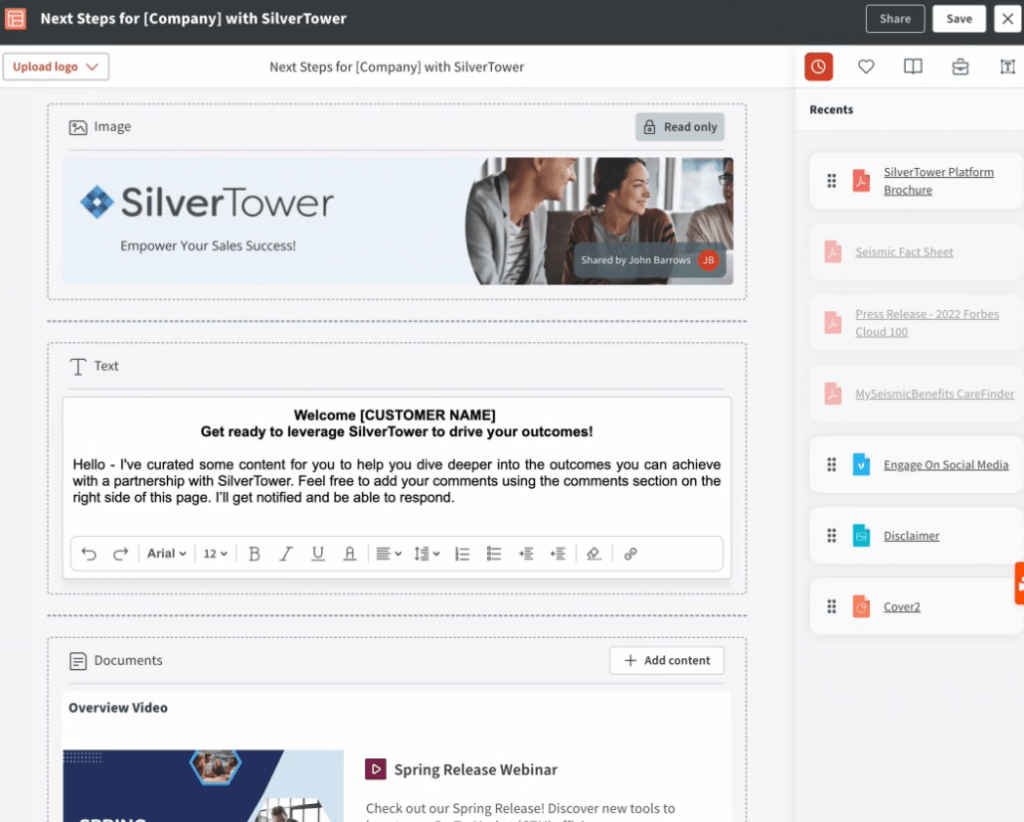
Once a digital sales room is live, visitors can interact with sales reps with comments. However, this feature seems to be localized, there’s no unified communication hub for reps to manage all client communications across sales rooms.
Seismic’s standout sharing feature is its “LiveDoc” functionality.
These are content hubs, also built in the profile builder and set to the “LiveDoc” type instead of “static”. Compared with static content, you can set these up to automatically fill with customer- or prospect-specific content before sharing (for example from Salesforce). LiveDocs also allows you to add and reorder slides and export them in PowerPoint, Google Slides, and PDF formats.
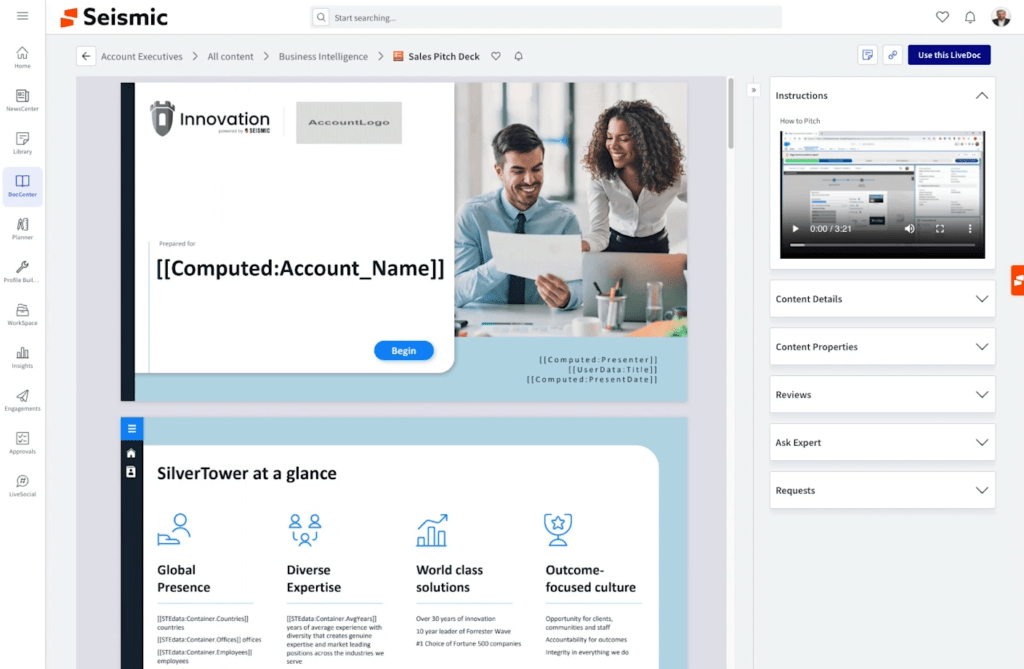
Then there’s SalesHood. All content in it is tagged as “internal-facing” or “external-facing” so no internal document gets shared accidentally. When setting content to external, you have three options:
- Quick share.
- Create a new Client Site.
- Add to an existing Client Site.
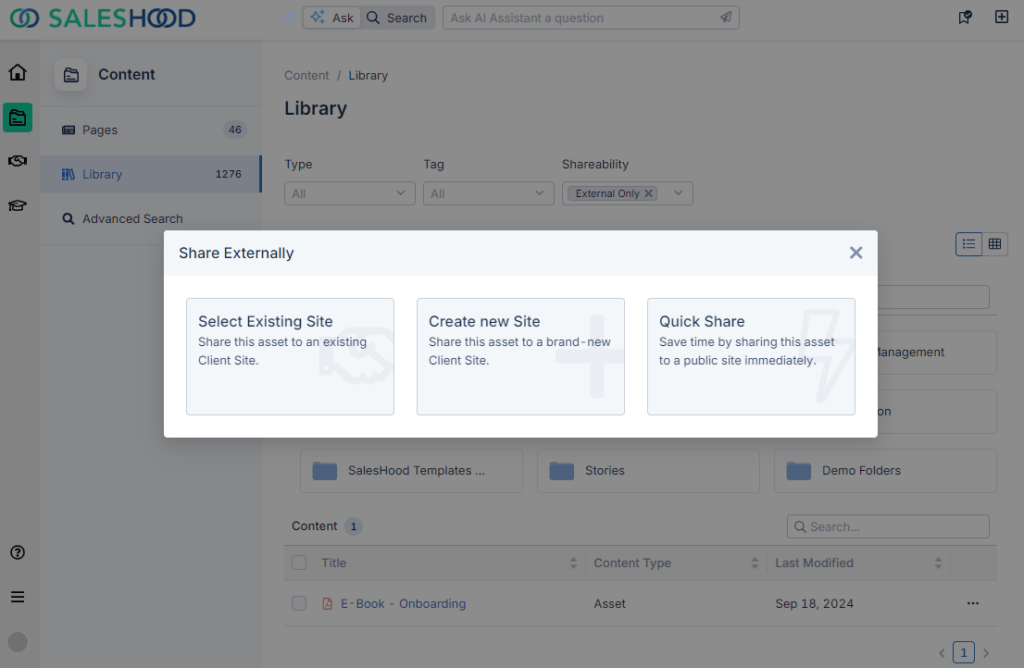
The “quick share” feature allows you to share approved content from the library with a link or via email.
Then there are “Client Sites”, SalesHood’s Digital Sales Rooms.
These offer a balance of simplicity and customization. You can create and manage them through the “Client Sites” toolbox. When creating a new site, you can put it into one of four categories:
- Prospecting,
- Active Deal,
- Customer Success,
- and Custom option.
These categories come into play with analytics, which we’ll cover in the next section.
Client Sites are essentially easy to create, manage content repositories, and promote buyer-seller collaboration. They’re designed so sales reps can quickly set up personalized Digital Sales Rooms without design skills, only with library content the marketing team flagged as approved “external”.
The site editor’s structure represents what a client will see on the front end: interactable content assets, organized into content groups.
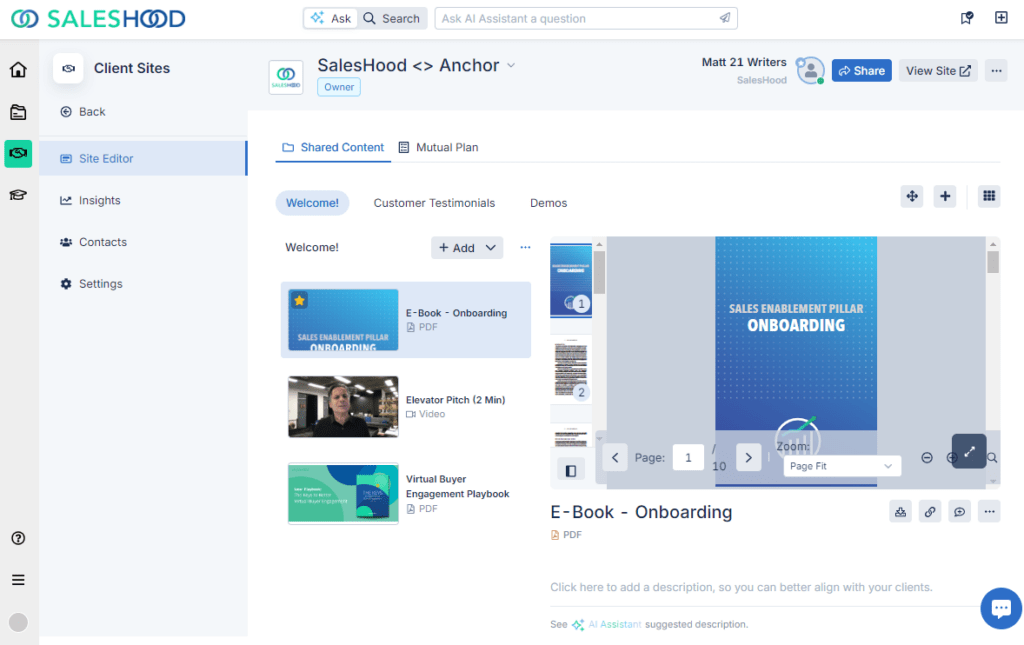
SalesHood also has an integrated chat feature, allowing sales representatives to communicate with clients. Unlike Seismic’s sales page-specific comments, SalesHood’s messaging also includes a unified inbox so sales reps can communicate with all clients in one place and don’t have to switch between different client sites.
But SalesHood’s Client Sites aren’t called “Prospect Sites” for a reason.
They help you manage the client post signature as well. After a client is onboarded, they’re great for sharing call recordings, EVRs, and product updates, and serve as a communication hub with SalesHood’s built-in messaging features.
A unique SalesHood feature that takes client management to the next level is “mutual action plans” to align buyers and sellers. With this recent addition, SalesHood is now the only Digital Sales Room platform that checks all 15 Gartner requirements for an ideal digital sales room platform.
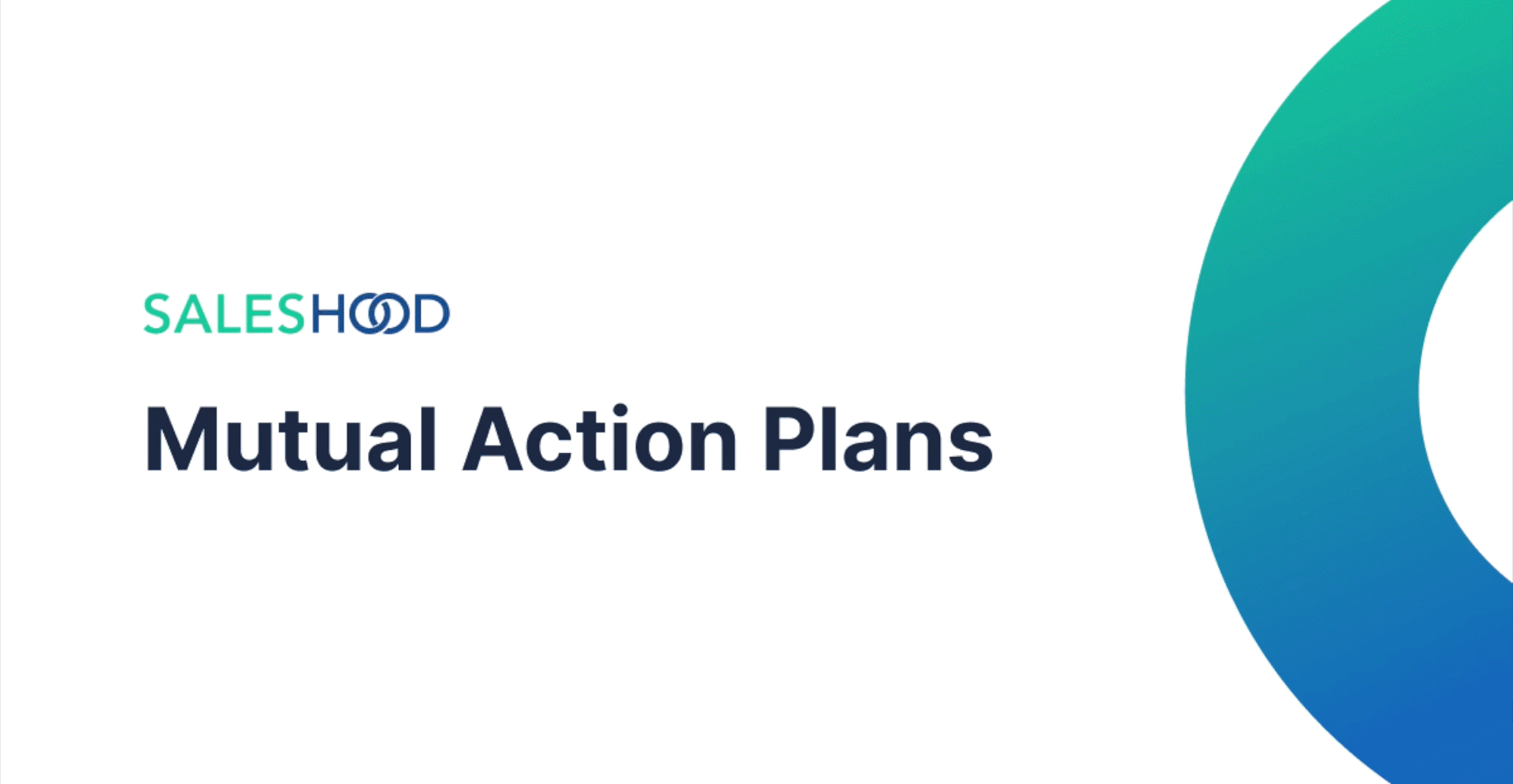
Buyer Engagement Insights and Analytics: Seismic has detailed session analytics, and SalesHood offers extensive Client Site analytics, including overall metrics and site-specific insights, with CRM integration for impact tracking.
Seismic | SalesHood |
|---|---|
In Seismic, the “Engagements” toolbox is where you track how people interact with your content.
It displays the activity of who interacted with the content and when. By clicking on individual interactions, you can access session analytics, which shows total session time, time spent on each piece of content, and user details like location and machine information.
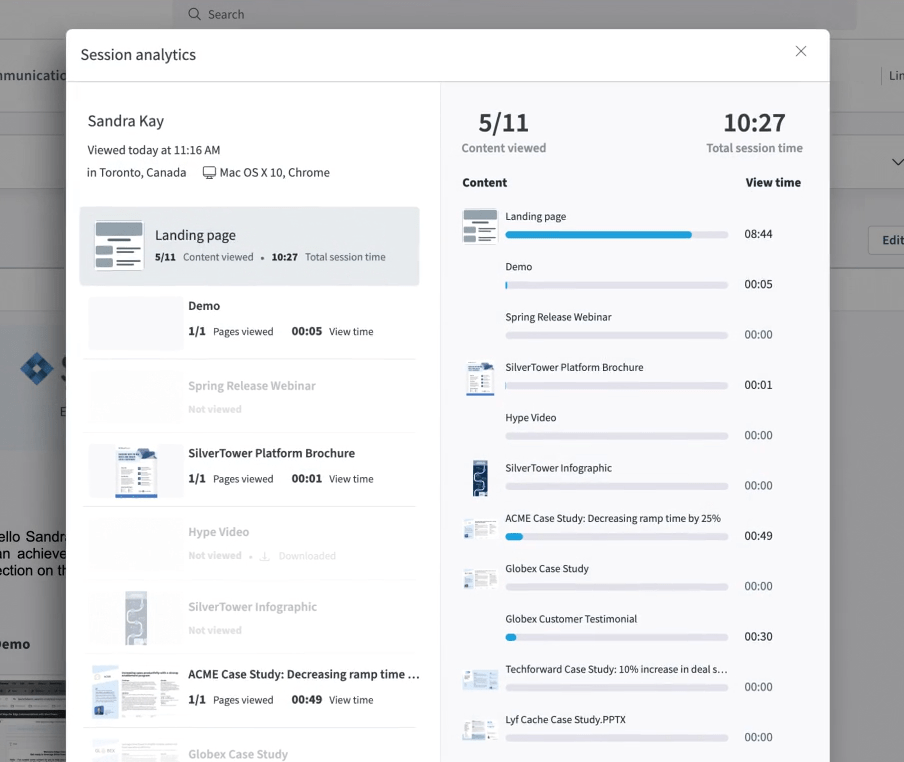
Then there’s SalesHood. Here, you get two types of Client Site Analytics.
The first one is overall sales room metrics through the “Client Sites” toolbox, under “Insights”. This is where you can see all seller activity, client engagement, and revenue impact metrics across all your sites over a set time. You can also filter by the owner and by site use case (prospecting, active deal, customer success, and others).

The second type of analytics is available in the “Insights” tab on each site and displays the site-specific insights. Here, you’ll find who is engaging with your site and their specific engagement metrics, which content is being engaged with most and its engagement metrics, and an event log to see the sequence of engagement by contact.
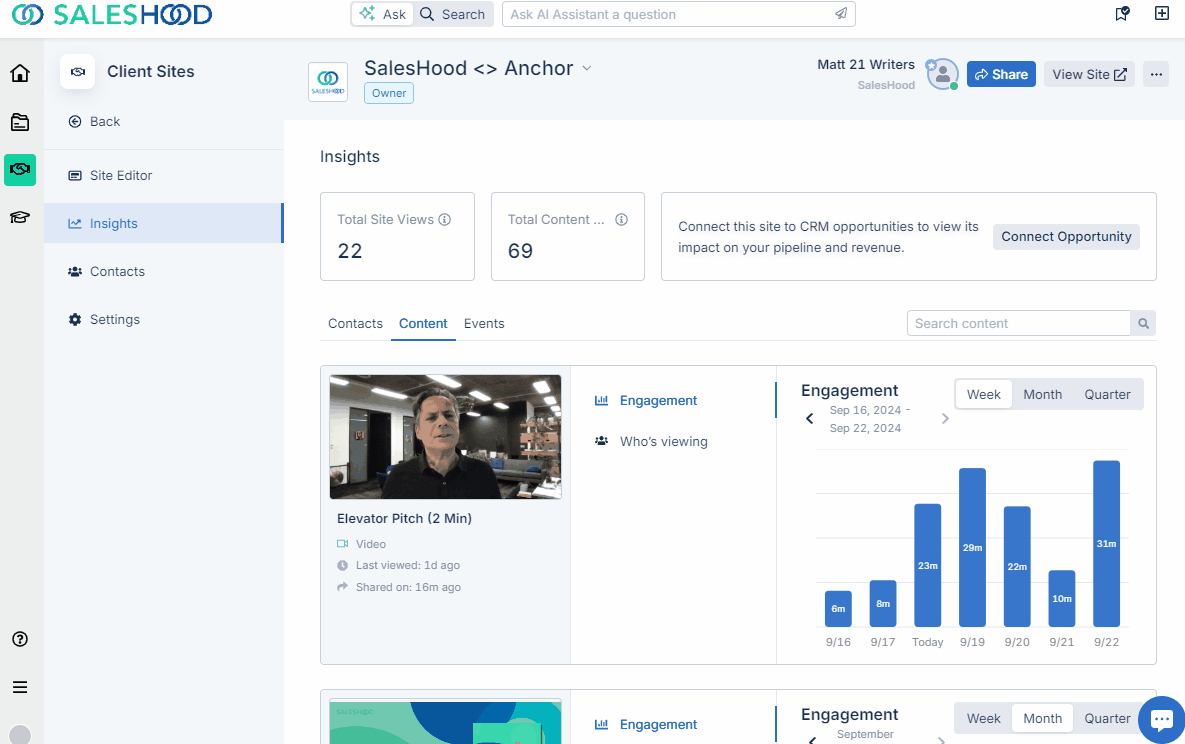
If your Salesforce CRM is connected, you can also track the impact your team is making through Client Sites and automatically log content interactions as activities in Salesforce.
Compared to Seismic, SalesHood gives you a more extensive overview of customer interactions.
BONUS SECTION — Advanced Engagement Features: Seismic offers social media tools, SalesHood provides AI-powered insights, and both platforms integrate AI for content search.
Seismic has a unique tool, LiveSocial.
This allows you to discover social media content relevant to your prospects and their niche. The primary benefit of it is that it aids sales reps in engaging with potential clients and creating content that resonates with your target audience.

The LiveSocial dashboard lets you set your interests, and Seismic surfaces posts related to those topics. You can connect your social profiles and schedule posts or send emails directly from Seismic. However, this scheduling feature is quite basic, and you’ll find specialized scheduling software more effective for this purpose.
SalesHood uses AI to generate summaries of call recordings.
This feature provides quick insights into conversations, beneficial for team members who weren’t present on the call or need a refresher on key points discussed.
Here’s an in-depth demo of SalesHood’s industry-leading AI features, in case you want to dive deeper into how it can help your team.
Seismic vs SalesHood: Pros & Cons
 |
|
|---|---|
| Seismic Pros | Seismic Cons |
| Powerful content analytics | Complex user interface |
| Robust approval and versioning system for regulated industries | Limited customization for TeamSites (content hubs) |
| "Planner" feature for managing content projects and tasks | No unified sales room communication hub |
| Customizable LiveDocs for dynamic content sharing | Steep learning curve due to numerous features and tools |
| LiveSocial tool for social media content discovery and engagement | Too many hard-to-justify features that aren’t used frequently, making it hard to use |
 |
|
|---|---|
| SalesHood Pros | SalesHood Cons |
| Most customizable and intuitive content organization | No social media tools like Seismic's LiveSocial |
| Rapid setup (30 seconds for a sales instance) | No skill metrics dashboard like Seismic |
| AI-powered content audit and automatic content archiving | Has a learning curve for utilizing all features effectively |
| Highly flexible and customizable pages | |
| Advanced AI-powered pitch practice and sales coaching with real-time analysis | |
| Comprehensive analytics for client interactions and revenue impact | |
| Mutual Action Plans for buyer-seller alignment | |
Final Verdict: Seismic vs SalesHood
Seismic provides powerful content management for large enterprises with strict needs, while SalesHood balances customization, flexibility, and AI for agile teams seeking rapid deployment and comprehensive revenue enablement.
Seismic | SalesHood |
|---|---|
| Best For Large enterprises with complex content management needs, prioritizing in-depth analytics and strict governance. | Best For Agile sales and marketing teams seeking a highly customizable, AI-driven platform with rapid implementation for unified revenue enablement. |
Seismic and SalesHood each cater to different organizational needs and priorities in the sales enablement space. Seismic offers powerful analytics and governance, while SalesHood provides a balance of customization, AI integration, and rapid deployment.
Use Seismic if:
- You’re a large enterprise with complex content management needs.
- You require powerful analytics and strict content governance.
- You need advanced content project management tools.
- You have dedicated teams to manage and analyze platform data.
Use SalesHood if:
- You have a small and nimble sales enablement team.
- You need a highly customizable platform that can be rapidly deployed.
- You’re looking for a unified platform for sales enablement and buyer engagement.
- You want advanced AI-powered features, including real-time pitch analysis.
- You need flexible learning tools with customizable paths and huddles.
- You want comprehensive client site analytics with CRM integration.

